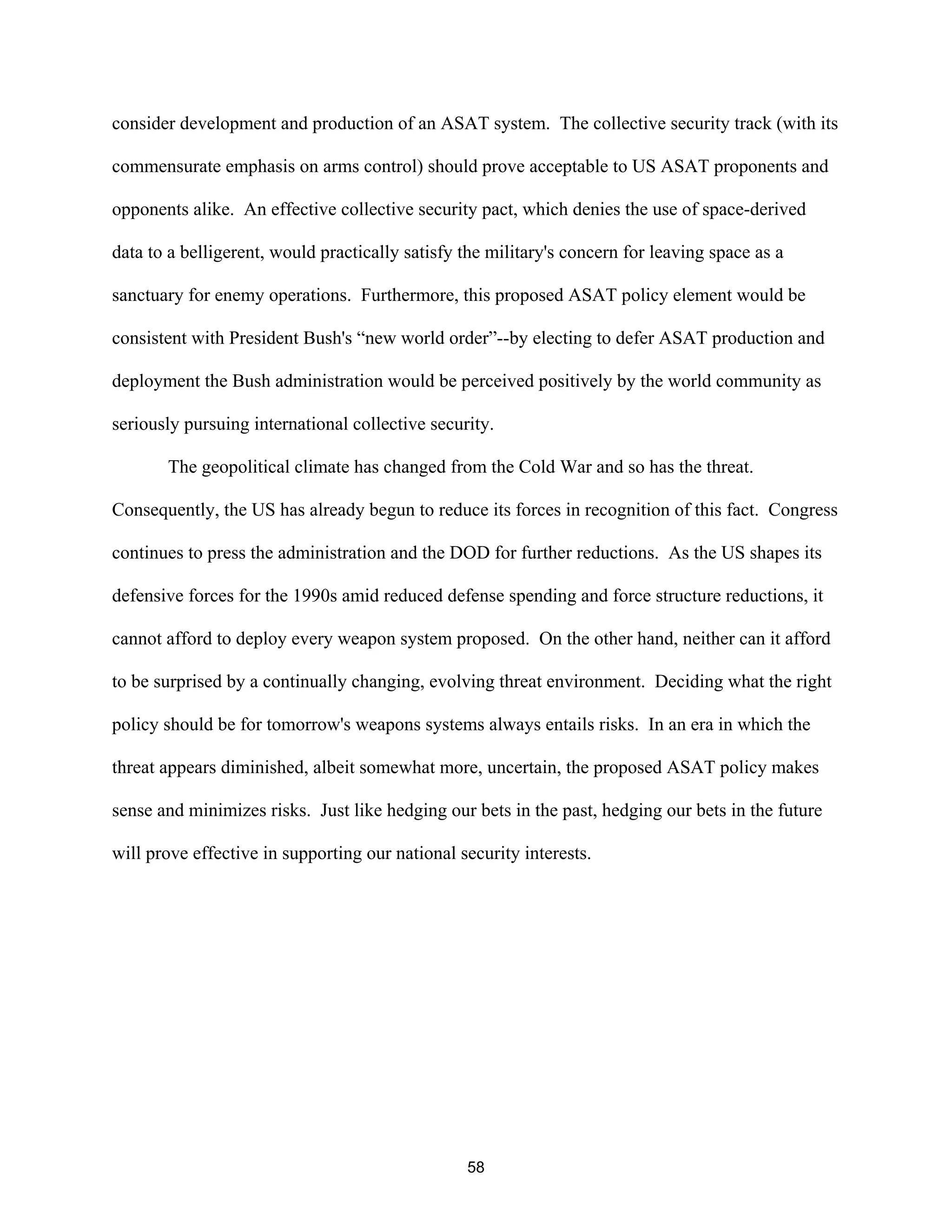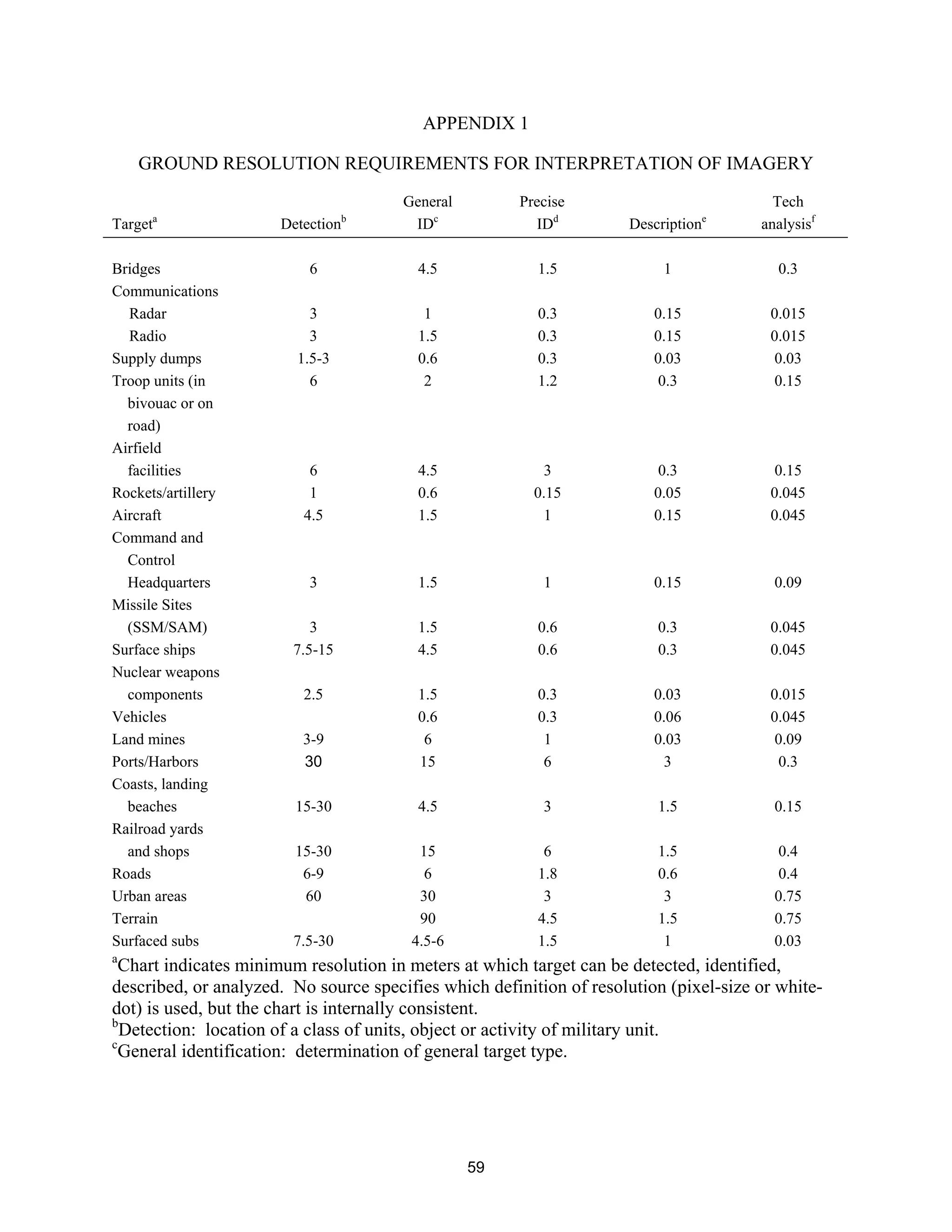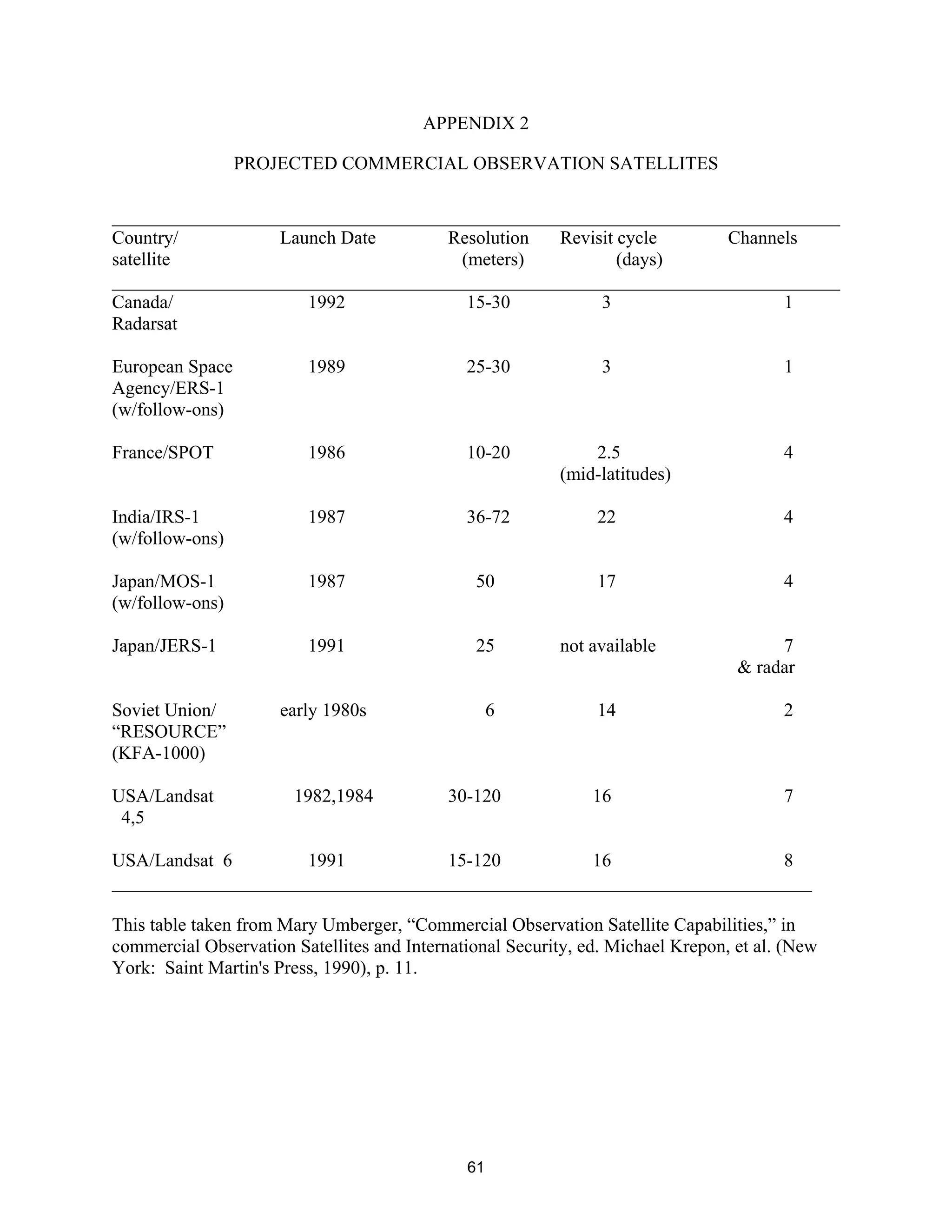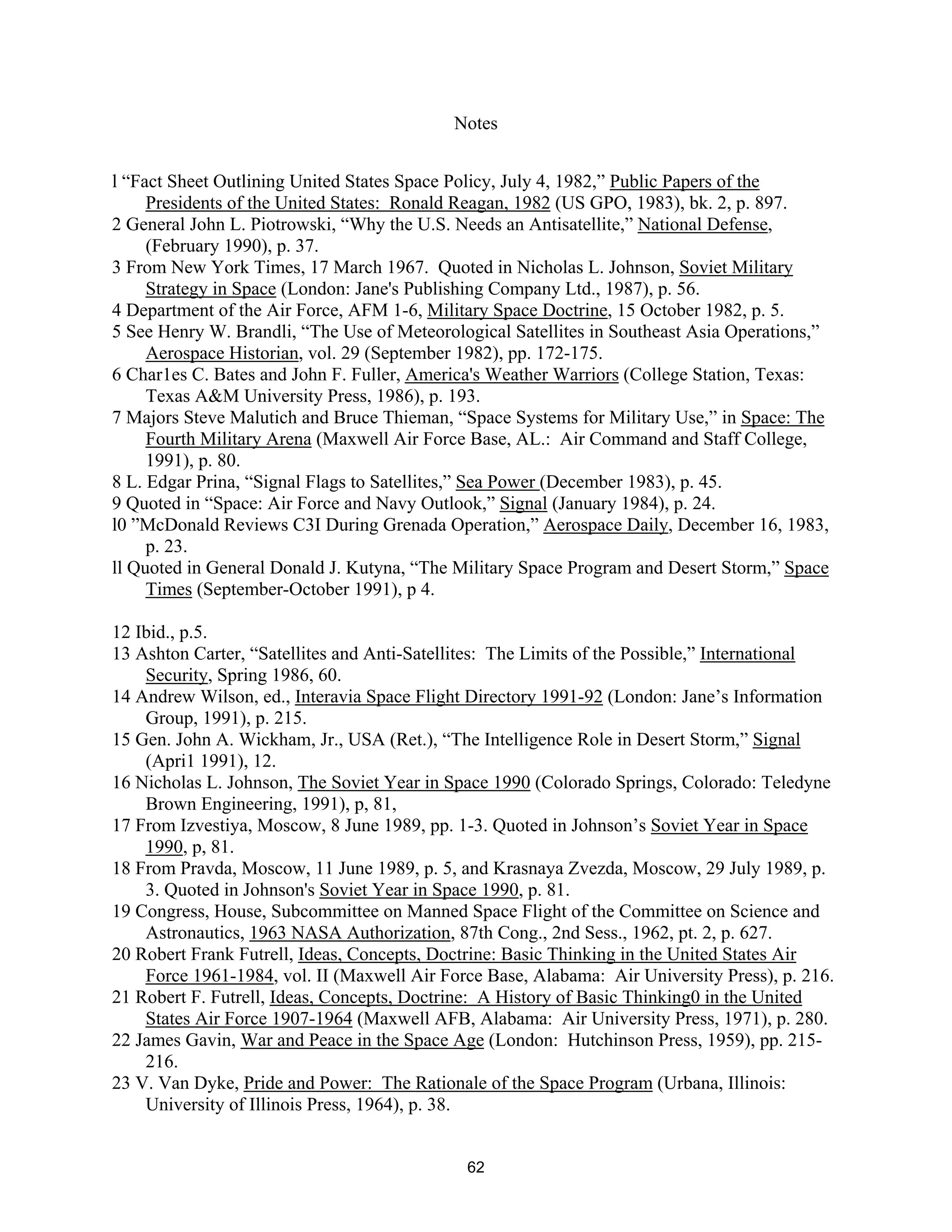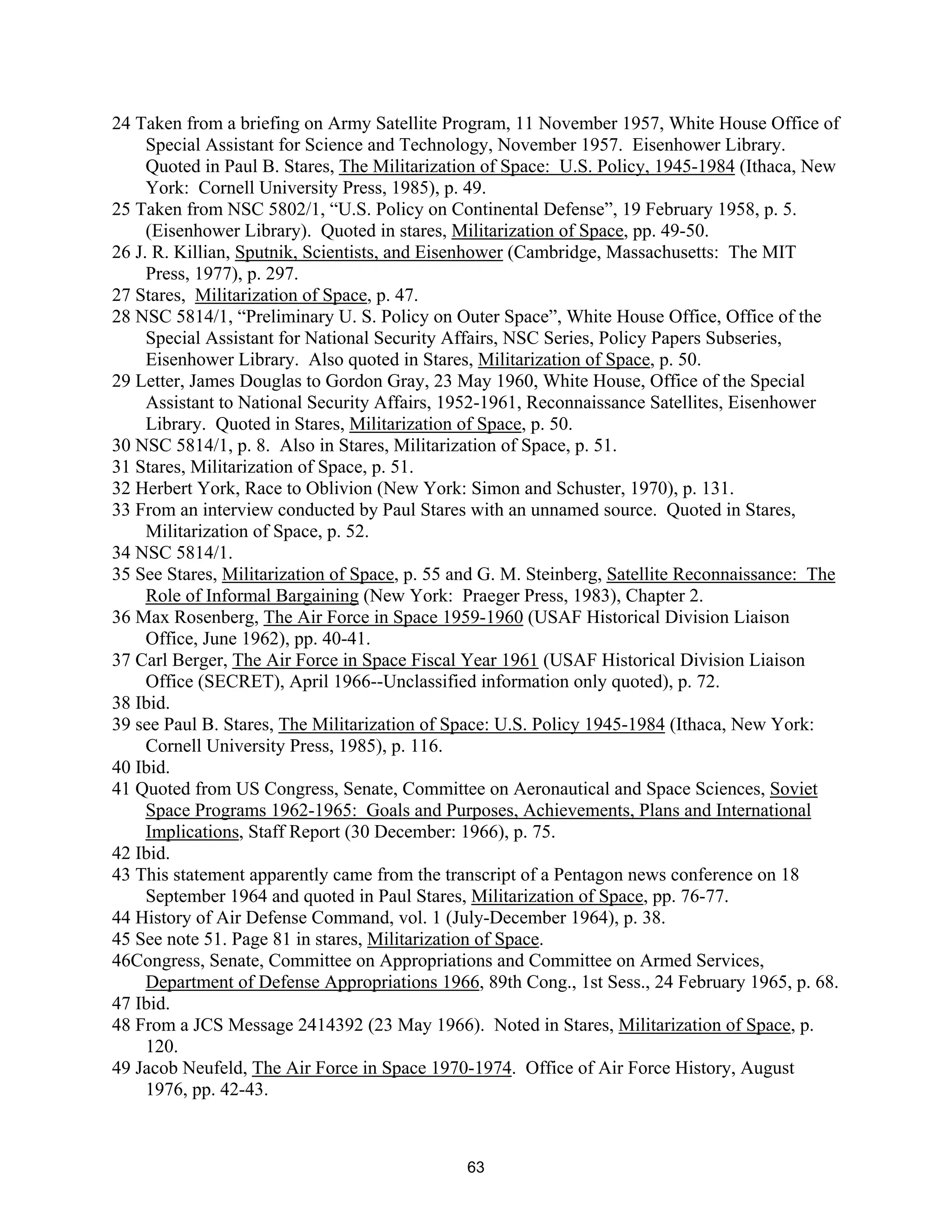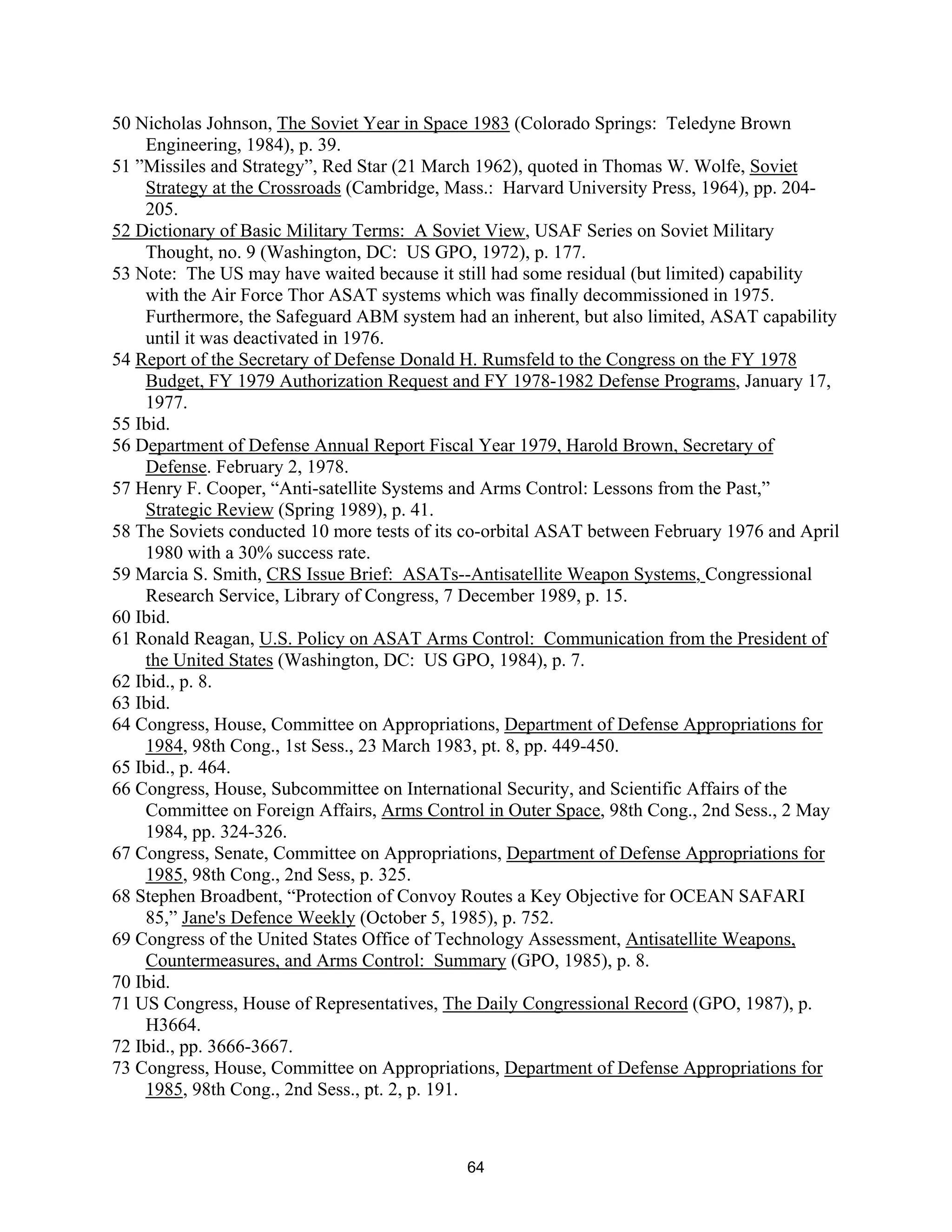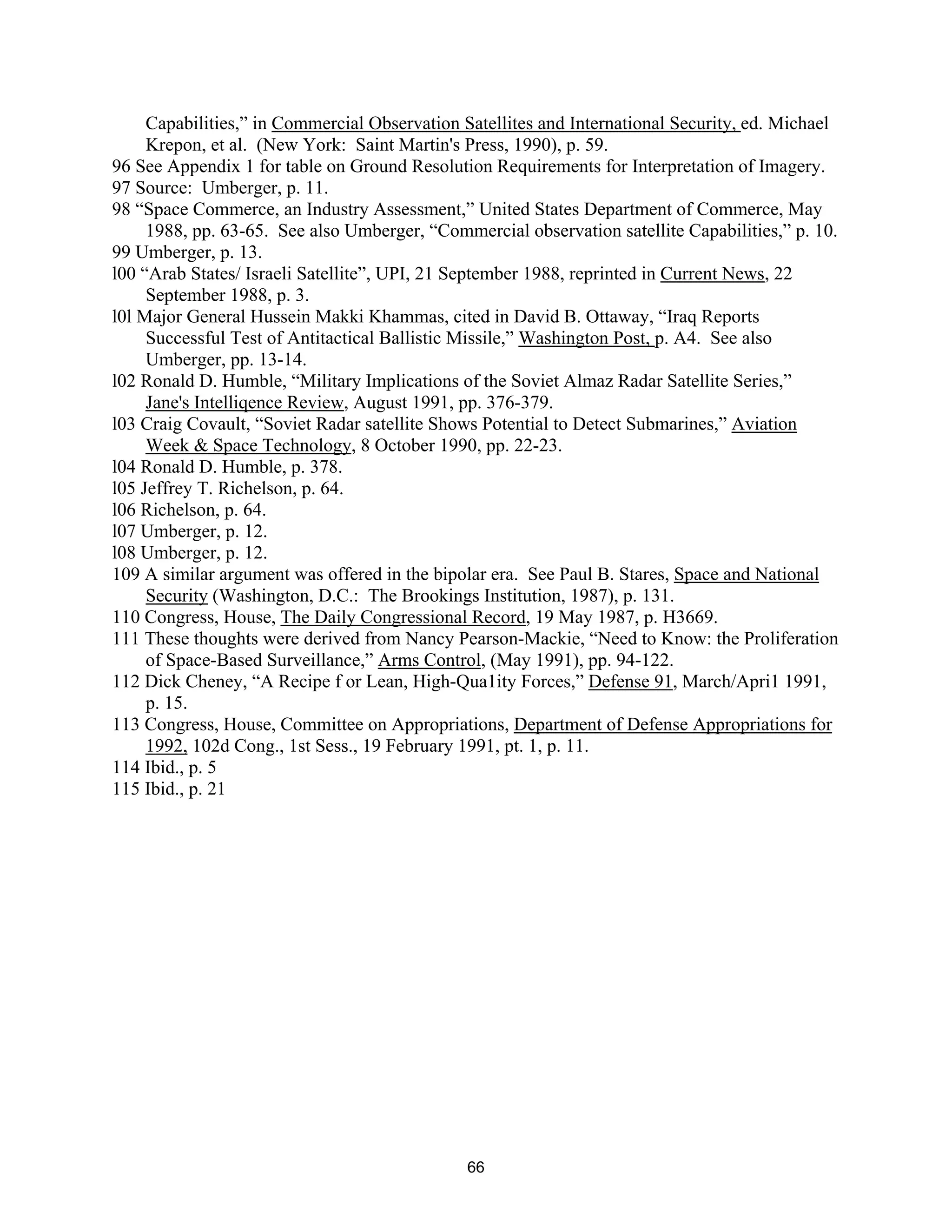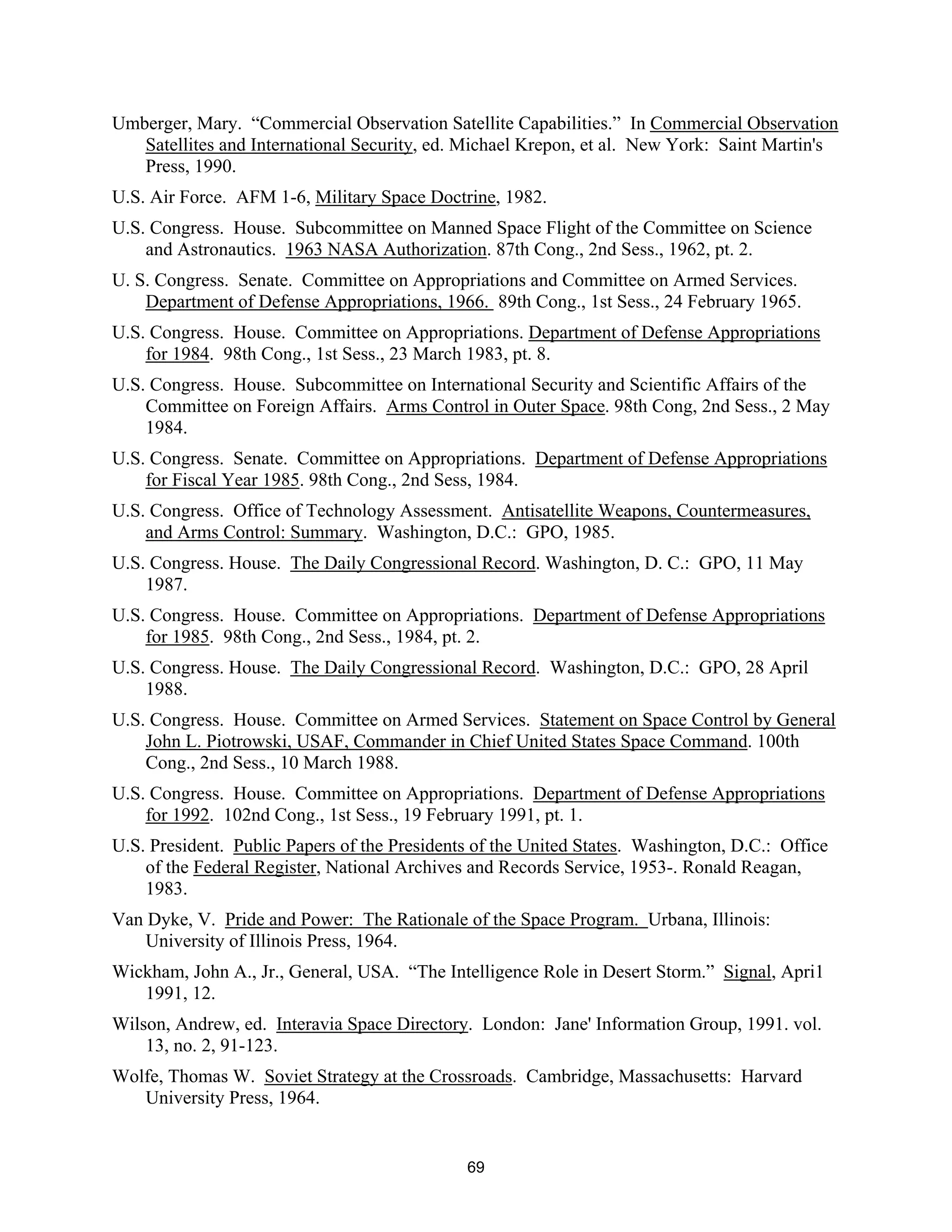This document discusses the role and value of military satellites. It notes that military space systems today play important roles in providing data and performing functions for militaries. Space systems augment the capabilities of surface forces by providing weather information, precise navigation data, communications, and surveillance. During the Vietnam War, weather satellites proved invaluable for weather monitoring and forecasting. General Momyer stated weather pictures from satellites were critical to his launch decisions. The document also notes that satellite communication systems carry a large portion of Department of Defense communications traffic at all levels. Having access to an adversary's military satellite capabilities, like weather satellites, could complicate their military planning.
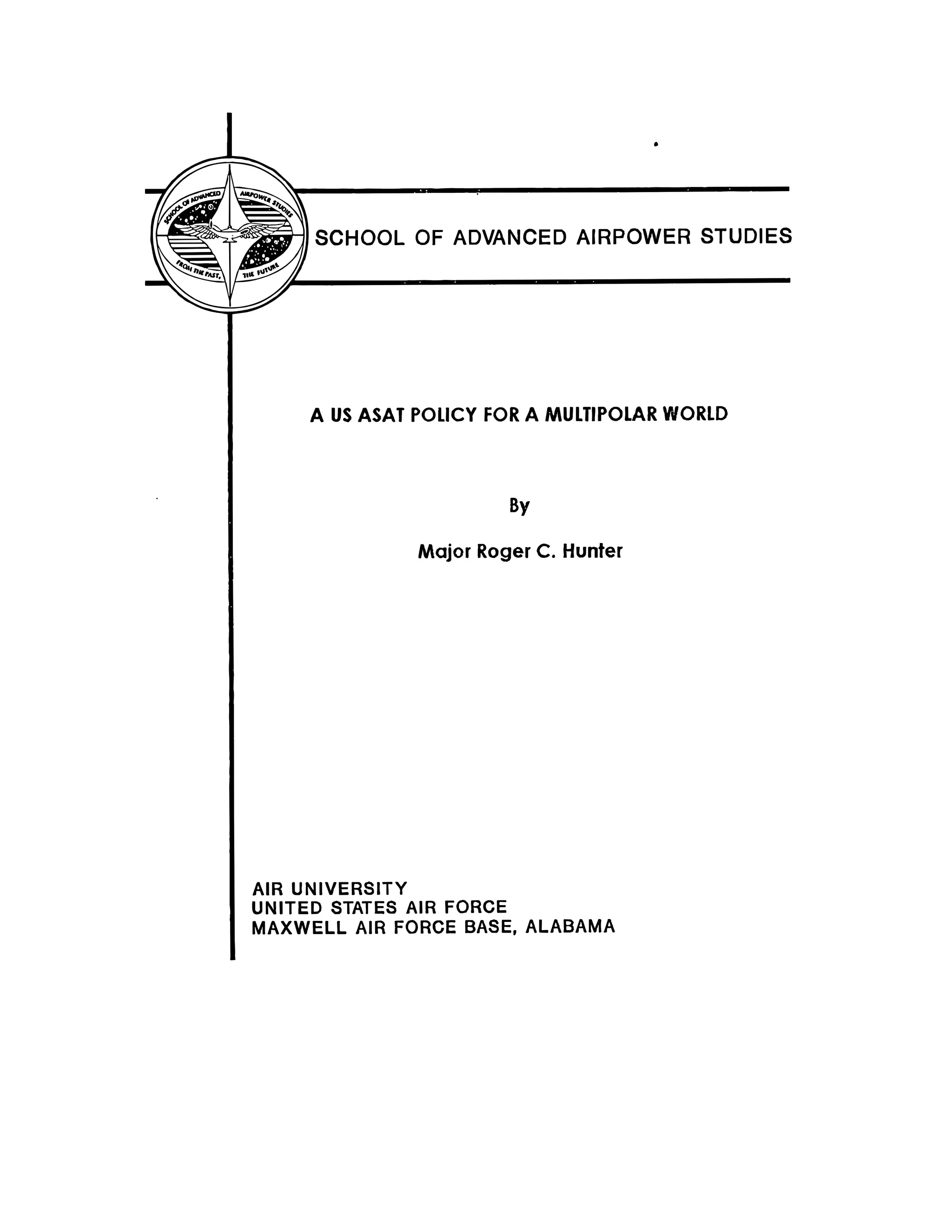
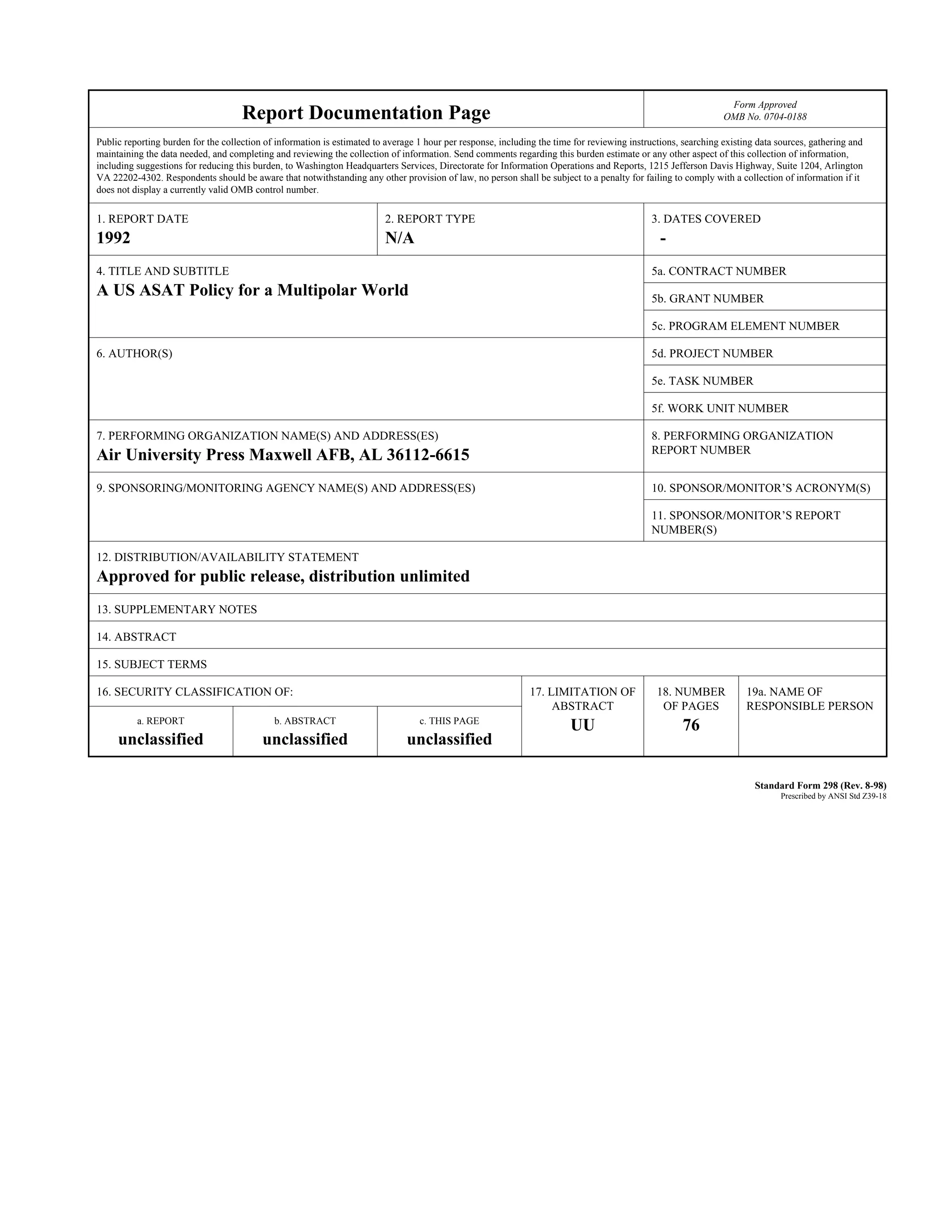

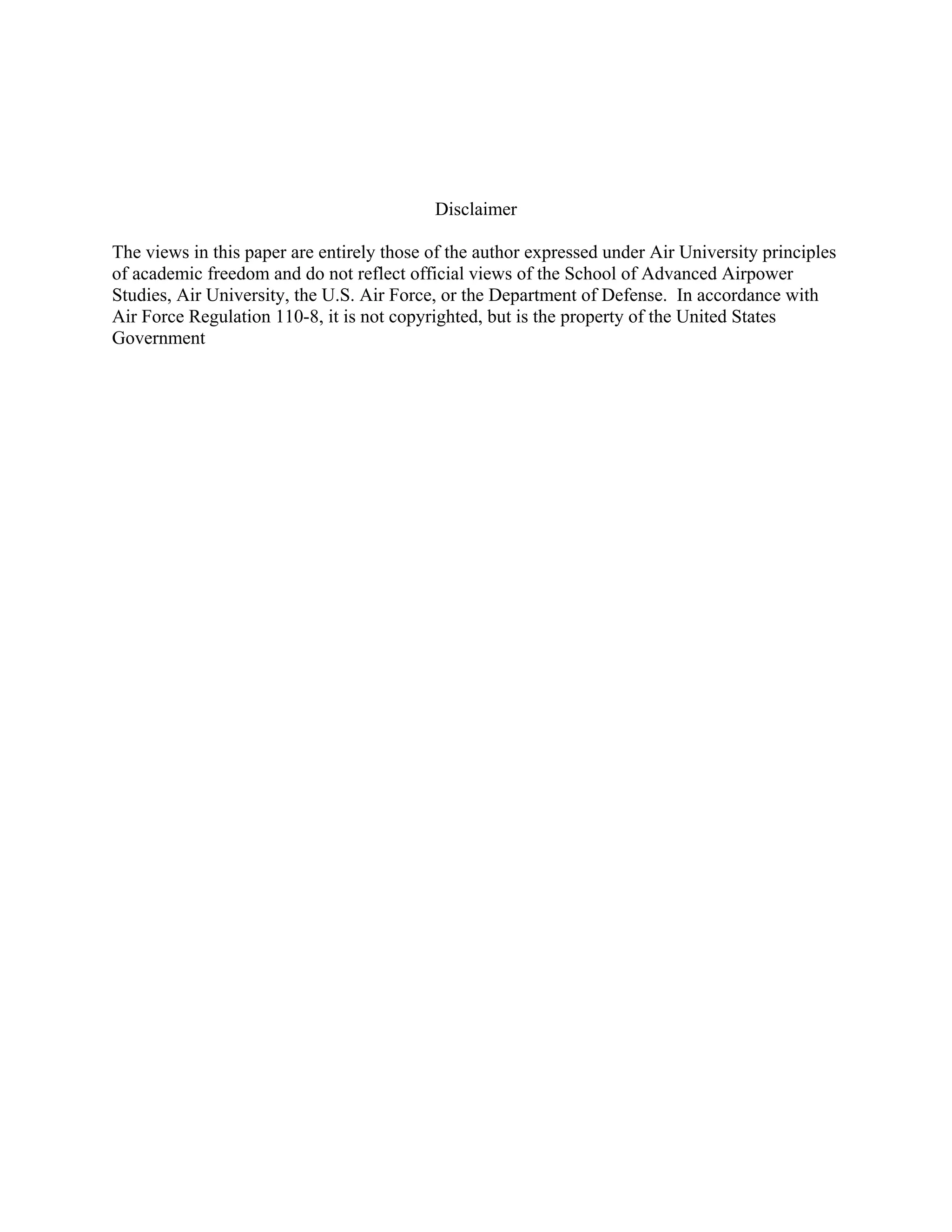

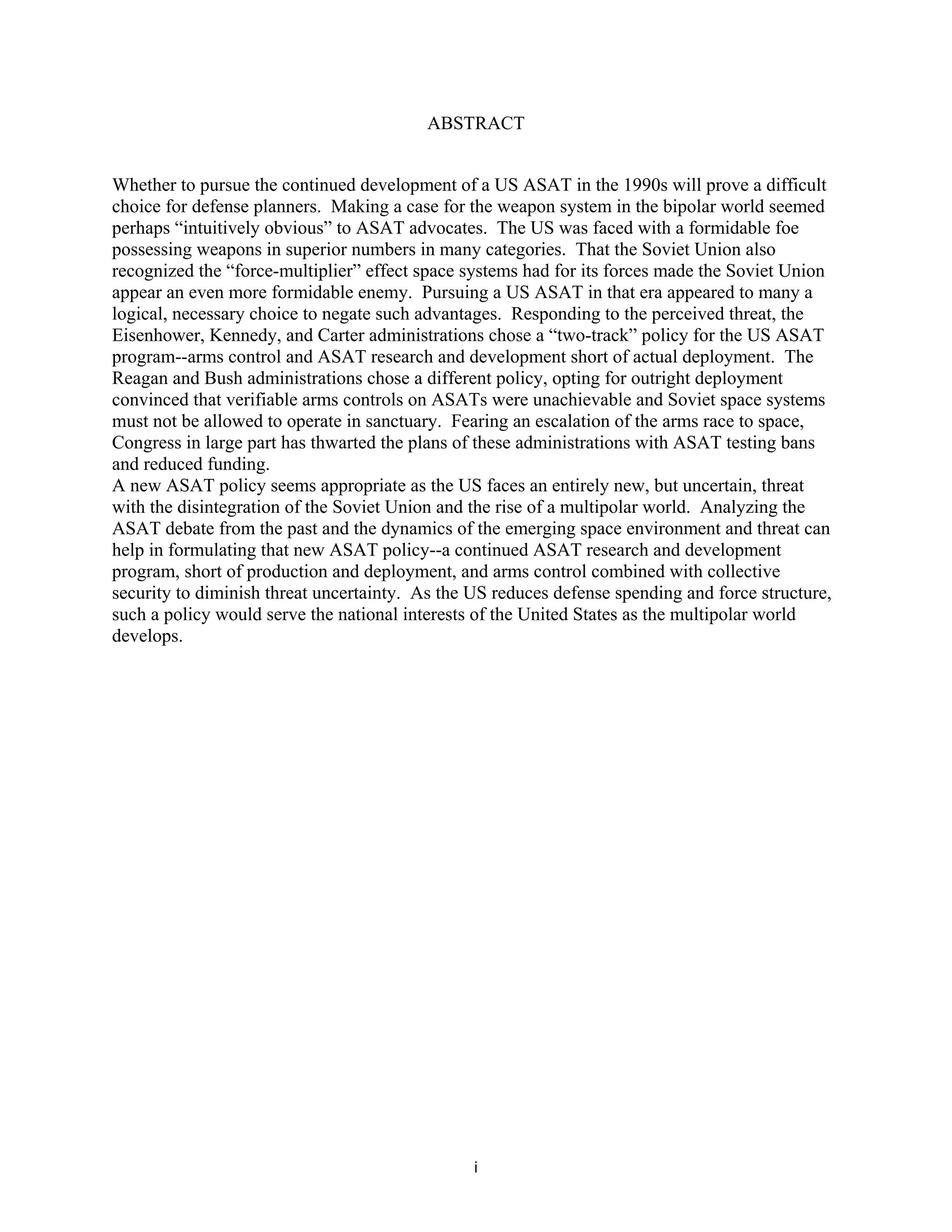
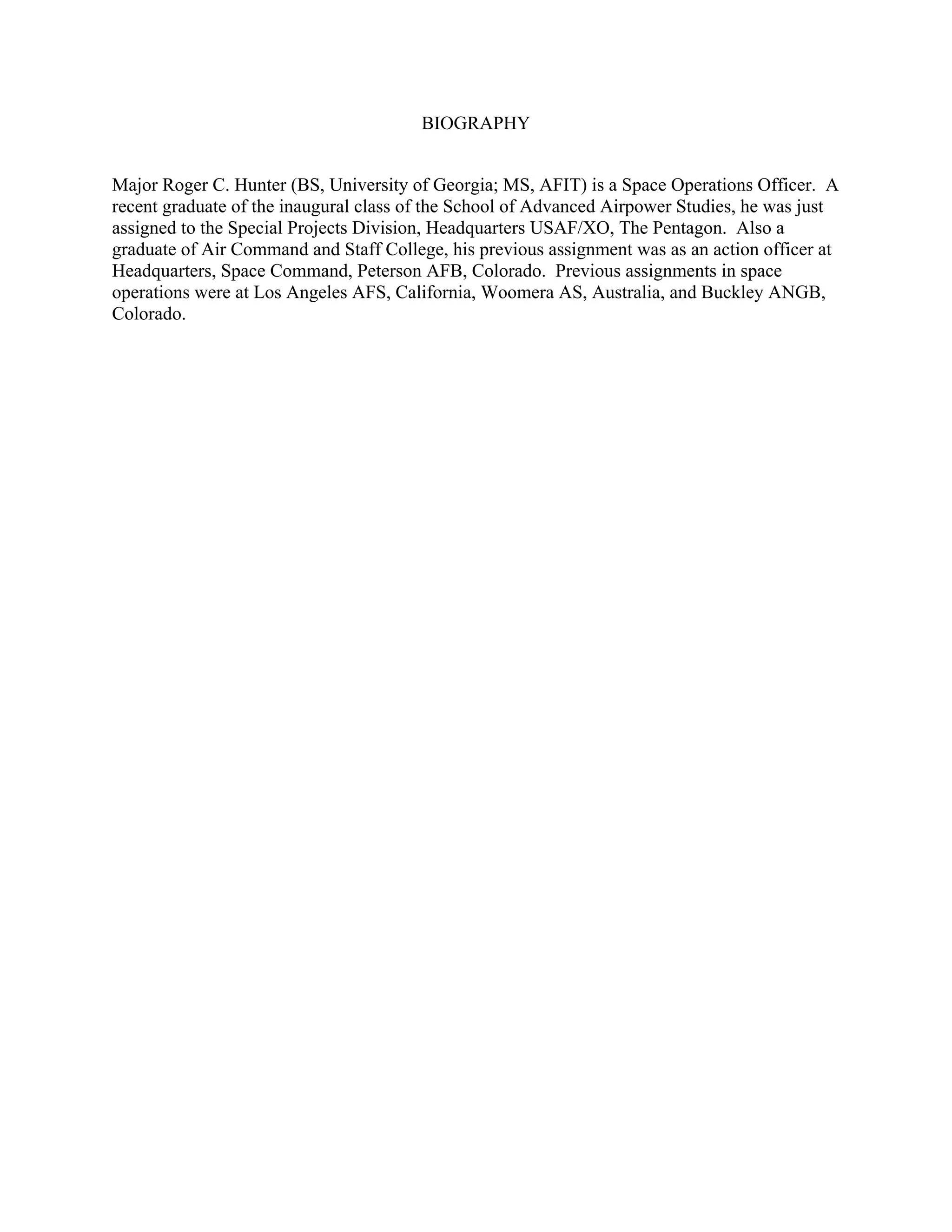
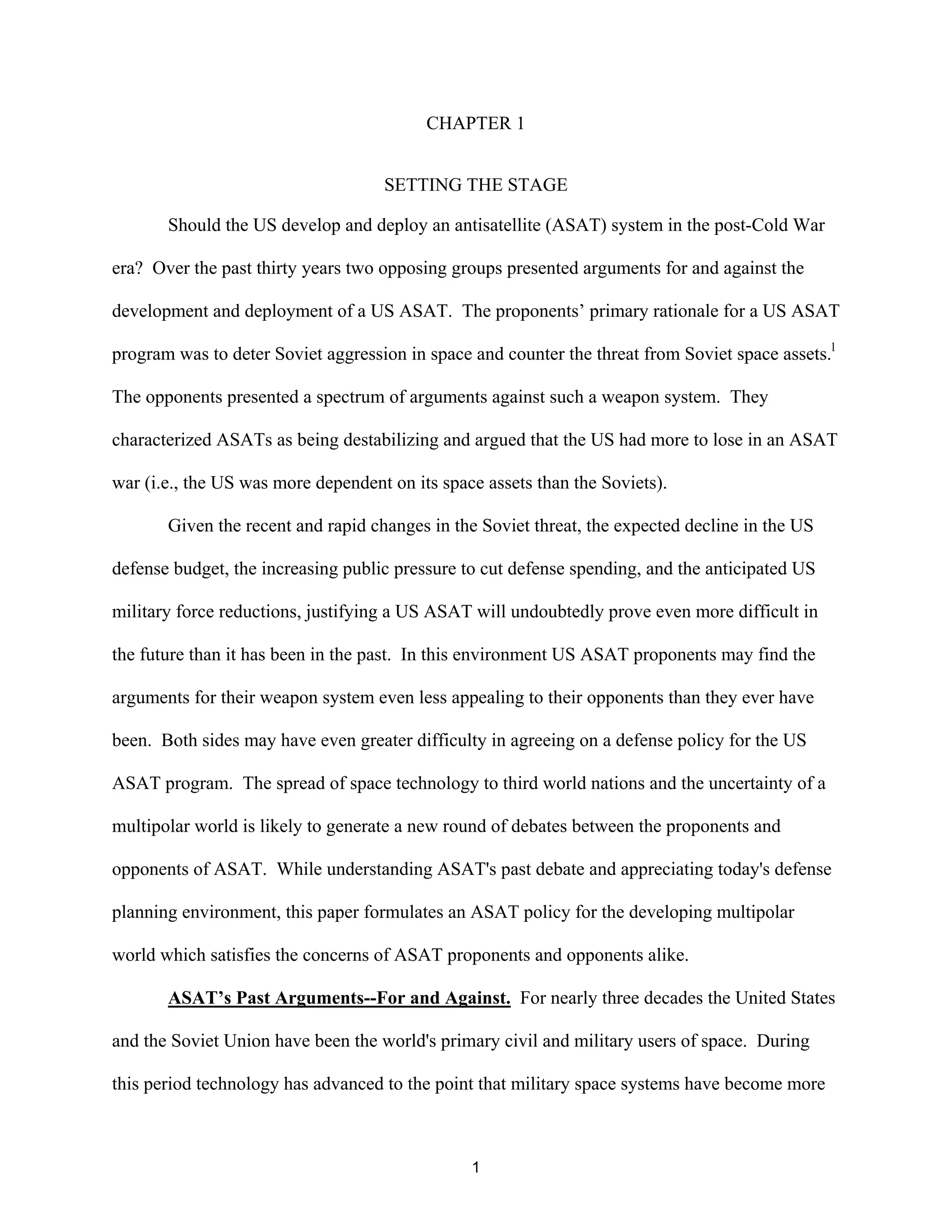
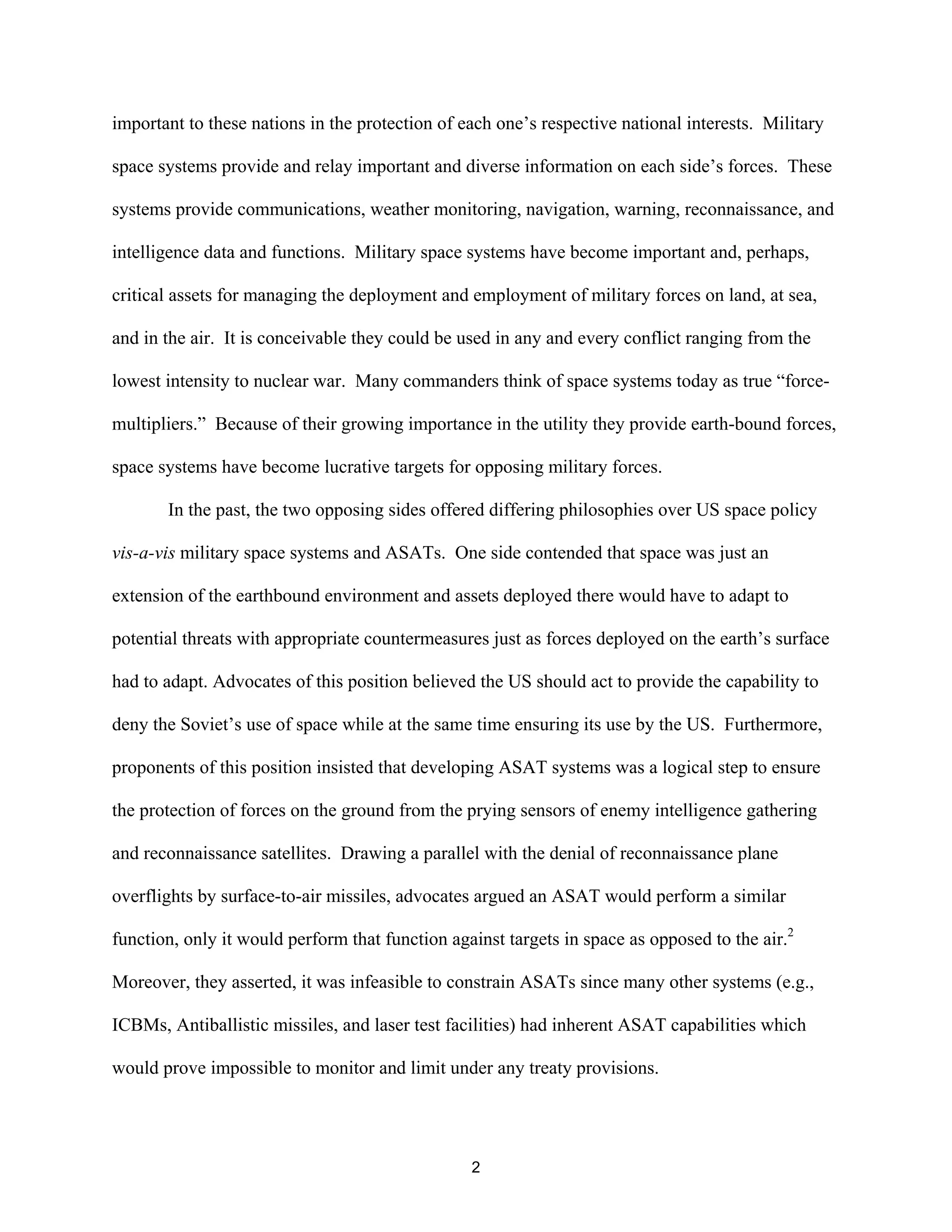



![CHAPTER 2
CONSIDERING THE ROLE AND VALUE OF MILITARY SATELLITES
In the latter years of his presidency, Lyndon Johnson looked back on the Cuban missile
crisis and noted”...if nothing else has come of it [the US space program] except the knowledge
we’ve gained from space photography it would be worth ten times what the whole program
cost.”3 Even in the early 1960s the national authorities were apparently beginning to appreciate
the value of space systems for observing the forces of another nation--observation that might
otherwise be denied by other means. President Johnson’s statement could be thought somewhat
prescient if one considers the growth into space the US and the Soviet Union experienced since
that crisis between the two nations nearly thirty years ago.
Today space systems for the US and the former USSR have taken on important roles in
providing data and performing functions for each side’s militaries. The US Air Force
acknowledges the importance space systems play in augmenting the capabilities of US surface
forces in the Air Force’s Military Space Doctrine: “To achieve their full potential, space systems
and operations must be fully integrated within existing military forces to become part of the total
force structure.”4 The systems and operations the doctrine refers to include, but are not limited
to, weather, communications, navigation, and surveillance.
Weather information and precise navigational data are essential for the conduct of
effective military operations. During the Vietnam War, weather satellites proved for the first
time their advantage over other means for weather monitoring and forecasting.5 Providing his
opinion on the importance of space derived weather information, General William Momyer
remarked:
6](https://image.slidesharecdn.com/jlefyjqprmysojsst3xu-signature-da39021f777369fcb57be006ccacd597162829cea87ab234b0450f76e72e8bf3-poli-140825182222-phpapp01/75/A-us-asat-policy-for-a-multipolar-world-13-2048.jpg)
![As far as I’m concerned, this weather picture is probably the greatest innovation
of the war. I depend on it in conjunction with the traditional forecast as a basic
means of making my decisions as to whether to launch or not to launch a
strike...The [DMSP] satellite is something no commander has ever had before in a
war.
without DMSP weather capabilities, how many strikes would General Momyer have delayed or
canceled? If Gerlera1 Momyer knew his adversary had a similar capability like DMSP, would
he have wanted to deny him that resource to complicate his military planning activities?
Weather is not the only function being provided by space forces to military commanders.
One military publication states “...satellite communication (SATCOM) systems carry a large
portion of intertheater and intercontinental DOD traffic and a significant portion of intratheater
or tactical communications.…..[and] provide the most effective means for naval communications
(except for line-of-sight traffic)...”7 The US Navy may be one of the bigger users of satellite
communications capabilities since its ocean-going fleets are not capable of using land or
undersea cables for relaying traffic. One military journal estimates the US Navy relies on
satellites for relaying 95 percent of its messages.8 In 1984 Vice Admiral Gordon Nagler
estimated the Navy was depending on satellites to relay 85 percent of its communications.9
Commenting on the criticality of satellite communications to US forces during the Grenada
operation, Admiral Wesley McDonald stated: “Satellite communications were used in most
cases all the way from the company level to the JCS...I don’t think I will surprise anyone when I
say that in this type of operation, satellite connectivity is absolutely essential.”l0 More recently,
military satellite communications systems demonstrated their value in the Persian Gulf Conflict.
General Donald J. Kutyna, testifying before the Senate Armed Services Committee, remarked:
Effective command and control of U.S. and coalition forces simply would have been
impossible without military satellite communication systems. Over ninety percent of the
communications to and from the area of operations were carried over satellite systems, and
7](https://image.slidesharecdn.com/jlefyjqprmysojsst3xu-signature-da39021f777369fcb57be006ccacd597162829cea87ab234b0450f76e72e8bf3-poli-140825182222-phpapp01/75/A-us-asat-policy-for-a-multipolar-world-14-2048.jpg)
![thousands of satellite communications receivers were used in theater down to the unit level. The
lack of a viable communications infrastructure in many areas of Saudi Arabia and Kuwait also
increased our dependence on satellite systems for intratheater command and control.”
In addition to weather and communications, military space systems provide precise
navigation and timing data to surface forces. Even though the U.S. Global Positioning System
(GPS) has not quite reached the full deployment of its entire constellation, it proved vital to the
success of Desert Storm operations. Coalition forces used GPS extensively to navigate in the
featureless terrain of Kuwaiti theater of operations and generate precise bombing and artillery
fire support. General Kutyna remarked that the “...[GPS] system in combat proved an
unqualified success...the lessons learned during Desert Storm will further increase our ability to
exploit this valuable hardware.”12 Had the U.S. and coalition forces not had the use of GPS
during Desert Storm operations, they could have used other sources for generating position and
timing data. However, the accuracy of that timing and position data would not have been as
precise as that provided by the GPS system. One can only speculate how the lack of GPS data in
Desert Storm would have affected coalition operations.
Finally, a number of reconnaissance and surveillance platforms, operating at various
altitudes and orbits, provide a means for detecting and characterizing other nations’ weapons
systems during peacetime. Intelligence data collection at the strategic level during peacetime is
normally a benign operation conducted without wartime tension. Ashton Carter asserts that one
would logically desire to use these surveillance capabilities for wartime purposes too, such as
“…tracking fleet movements, locating rear area targets, sorting out enemy lines of supply and
command, monitoring activities at airbases, intercepting communications, warning of enemy
advances and so on.”13 For example, Jane’s Information Group asserted allied commanders used
8](https://image.slidesharecdn.com/jlefyjqprmysojsst3xu-signature-da39021f777369fcb57be006ccacd597162829cea87ab234b0450f76e72e8bf3-poli-140825182222-phpapp01/75/A-us-asat-policy-for-a-multipolar-world-15-2048.jpg)
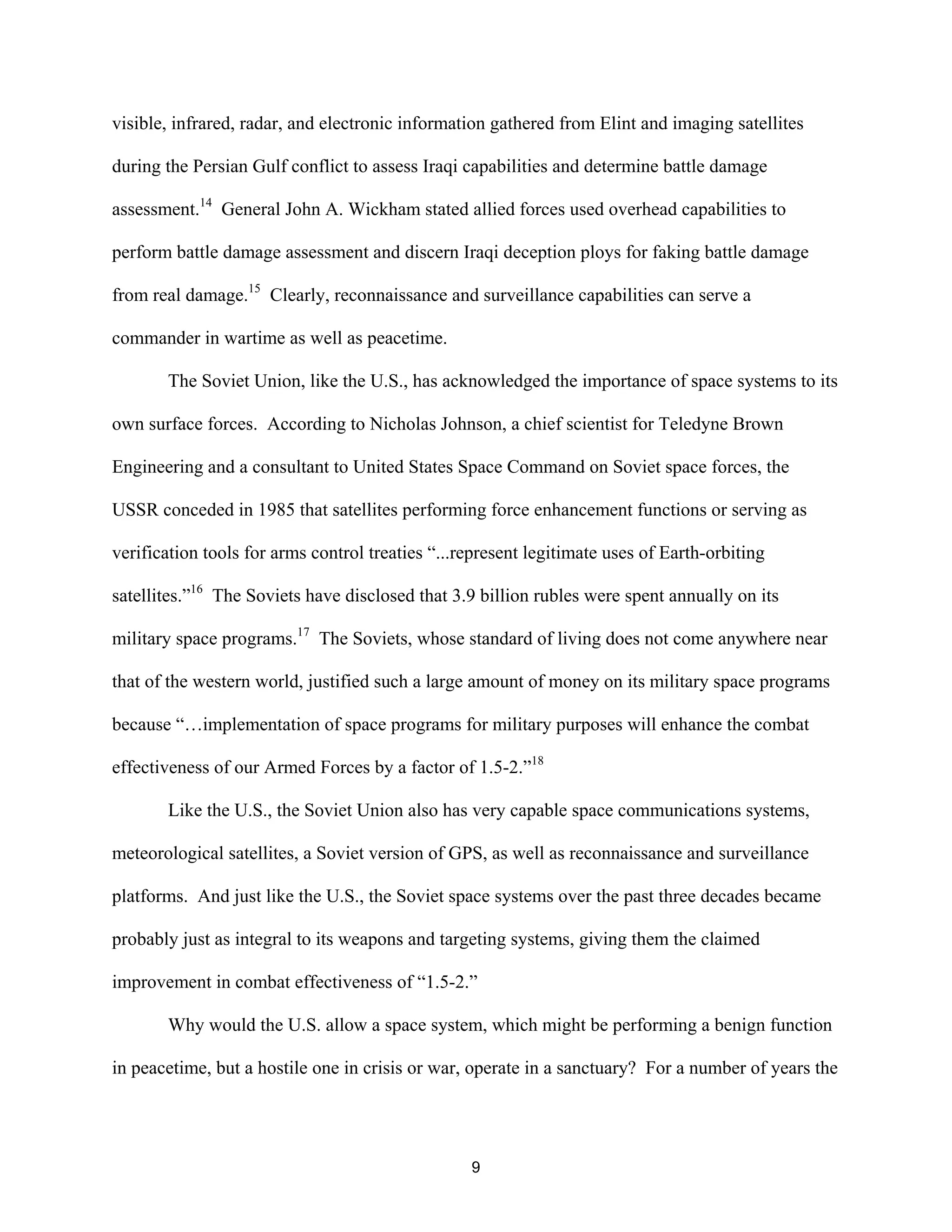
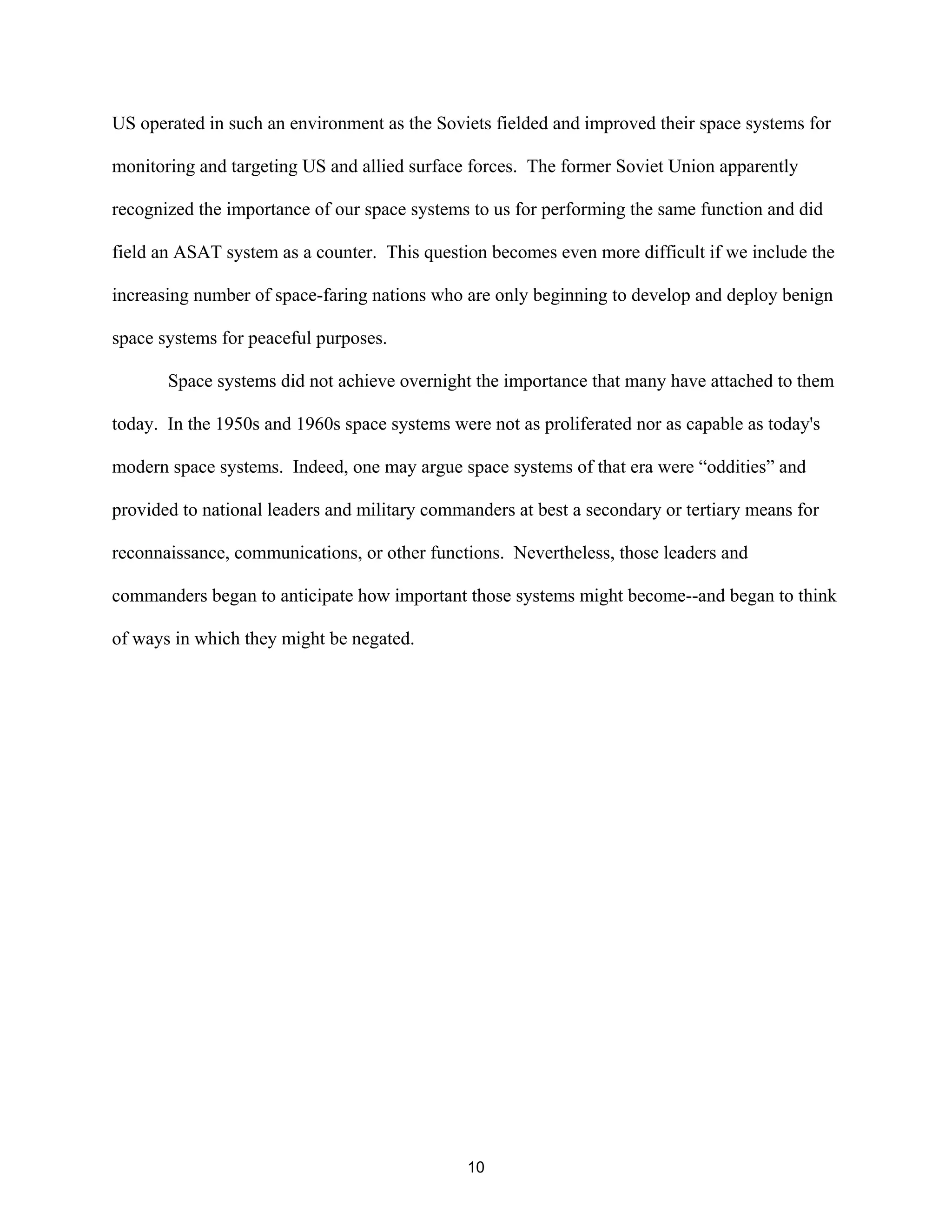
![CHAPTER 3
ASAT’S GENESIS: THE ARGUMENTS BEGIN
You do not have 50 and 100 megaton bombs. We have bombs stronger than 100
megatons. We placed Gagarin and Titov in space and we can replace them with
other loads that can be directed to any place on earth.19
Nikita Khrushchev, 9 August 1961
The Soviet launch of Sputnik and other bellicose statements by the Soviet leadership
prompted a dramatic rise in the number of speeches calling for a vigorous US space program.
The U.S. Air Force in turn commissioned in 1961 its first ten-year space plan. Completed in
September, the plan called for a number of initiatives including the urgent development of a
satellite interception system which had already been under study.20 Not to be left out, the US
Army and US Navy developed their own space initiatives including antisatellite concepts. The
services began a number of investigatory space projects in the second half of the Eisenhower
administration, but before any of them could be brought to a developmental, production, or
deployment phase they had to meet the test of Eisenhower administration policies. This chapter
reviews the Eisenhower administration’s space policies vis-a-vis antisatellites and the US Air
Force’s early antisatellite project of the 1960s. The incipient arguments and justifications offered
for and against the “weaponization of space” during this period are presented as the foundation
upon which the antisatellite controversy was born and has grown to this day.
Early Arguments for ASAT. As the space age began, the military services began to voice
their requirements for space control. In a speech on 29 November 1957, Air Force Chief of Staff
General Thomas White said he “...[felt] that in the future whoever has the capability to control
space will likewise possess the capability to exert control of the surface of the earth.”2l The
11](https://image.slidesharecdn.com/jlefyjqprmysojsst3xu-signature-da39021f777369fcb57be006ccacd597162829cea87ab234b0450f76e72e8bf3-poli-140825182222-phpapp01/75/A-us-asat-policy-for-a-multipolar-world-18-2048.jpg)
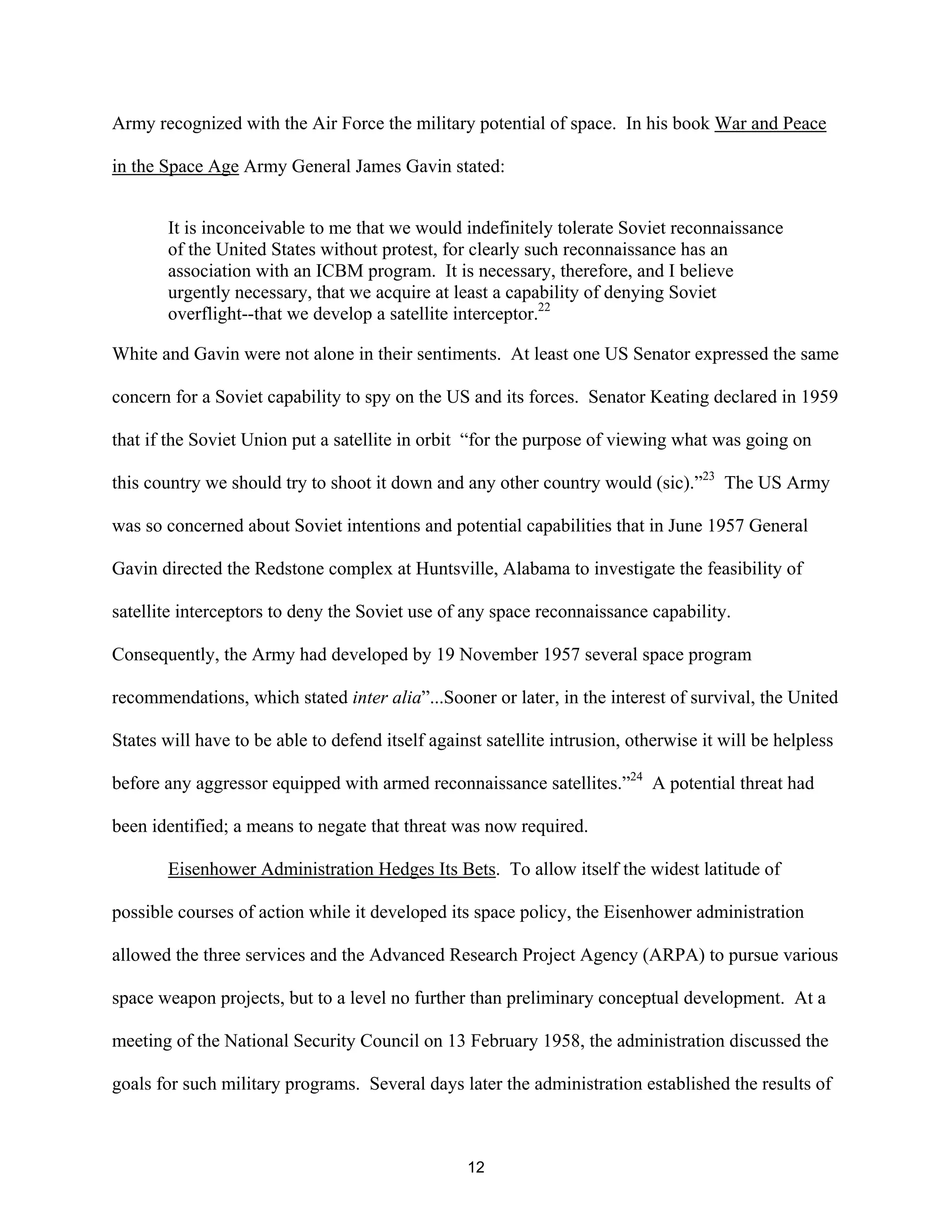
![that meeting in NSC 5802/1, a document entitled “U.S. Policy on Continental Defense.” The
document listed “Defense Against Satellites and Space Vehicles” as an area of “particular
importance” where a “...vigorous research and development program should be maintained in
order to develop new weapons and needed improvements in the continental defense system and
to counter improving Soviet technological capabilities for attack against the United States.”25 It
would appear then that the administration had some concern over the threatening potential of
space systems hinted at by Khrushchev. Nevertheless, the Eisenhower administration resisted
U.S. military service pressure to deploy any robust capability to negate any potential Soviet
reconnaissance satellites or space weapon systems for a number of reasons.
Resisting ASAT. First, the Eisenhower administration held little regard for any potential
threat the Soviets might develop in reconnaissance satellites or orbital bombardment systems. At
the request of President Eisenhower in 1958, Edward Purcell led a special panel of the
Presidential Science Advisory Committee (PSAC) to recommend the outlines of a national space
program. The report, endorsed by Eisenhower on 26 March 1958, emphasized the beneficial
aspects of the scientific use of space as opposed to its “militarization.” It did include an
optimistic discussion of a number of potential “passive” military uses of space, such as weather
forecasting, reconnaissance, and communication. Notably, however, the report stated: “Much
has been written about space as a future theater of war, raising such suggestions of satellite
bombers, military bases on the moon and so on. For the most part, even the more sober
proposals do not hold up well...In short, the earth would appear to be after all, the best weapons
carrier.”26 Author Paul stares believed “...the [Purcell] report’s endorsement of the passive
military benefits of space and its unequivocal rejection of the utility of space weapons
established the basic quidelines of the US military exploitation of space.”27 Following the
13](https://image.slidesharecdn.com/jlefyjqprmysojsst3xu-signature-da39021f777369fcb57be006ccacd597162829cea87ab234b0450f76e72e8bf3-poli-140825182222-phpapp01/75/A-us-asat-policy-for-a-multipolar-world-20-2048.jpg)
![Purcell report, NSC 5814/1, while recognizing the potential of soviet satellite capabilities to
provide some military capabilities, stated the “...development of a weapon system to counter
soviet satellite reconnaissance offered marginal benefits to the United States, especially as the
Soviet Union could gain virtually all the information that satellites provided from open U.S.
sources.”28 Within the Defense Department itself there seemed to be a difference of opinion over
the requirement for a satellite interceptor. In spite of the views previously expressed by Generals
White and Gavin, on 23 May 1960 Deputy Secretary of Defense James Douglas stated:
The Defense position is that there is no urgent requirement for a capability to
intercept satellites. There is no clear indication that the Soviets are expending
effort on reconnaissance satellites or on weapon-carrying satellites. Such
reconnaissance would seem to offer little attraction to them, and the utility of an
offensive satellite weapon in the near future is very questionable.29
Secondly, the Eisenhower administration doubted the utility of the space weapon
(meaning orbiting bomb) itself. As the Purcell report indicated, land-based systems such as
IRBMs and ICBMs would be superior to an orbiting bombardment system. Therefore, logic
dictated the Soviets should eventually arrive at the same conclusion, obviating the need for the
U.S. to develop an antisatellite to negate any Soviet orbiting bombardment system.
Ironically, the expected growth and use of the US reconnaissance satellites was the most
compelling reason the Eisenhower administration used in checking its own military services’
desire to weaponize space. NSC 5814/1 stated: “Reconnaissance satellites are of critical
importance to U.S. national security.”30 Supposedly the differences in the societies of the US
and USSR made the satellites more critical to U.S. national security. Paul Stares offered the
opinion that”...[g]iven the closed nature of Soviet society, reconnaissance satellites were seen to
have greater value to the United States than the Soviet Union.”3l If US reconnaissance satellites
were to actually become of greater value to US national security than the USSR, then logically
14](https://image.slidesharecdn.com/jlefyjqprmysojsst3xu-signature-da39021f777369fcb57be006ccacd597162829cea87ab234b0450f76e72e8bf3-poli-140825182222-phpapp01/75/A-us-asat-policy-for-a-multipolar-world-21-2048.jpg)
![the USSR, not the US, would have the greater incentive to develop antisatellite weapons.
Indeed, Herbert York, who at one time was Director, Defense Research and Evaluation
(DDR&E), remarked, “The President himself, in recognition of the fact that we didn’t want
anybody else interfering with our satellites, limited [one ASAT] program to study only status and
ordered that no publicity be given either the idea or the study of it.”32 Another former Defense
Department official seemed to confirm President Eisenhower’s position: “He (President
Eisenhower) was opposed to antisatellites because he felt that satellites were more to our benefit
than to the Soviets and he did not want us to do anything that would initiate antisatellite
warfare.”33 Much of Eisenhower’s position on the military use of space was captured in NSC
5814/1, whose Policy Guidance section stated the U.S. should “...[i]n anticipation of the
availability of reconnaissance satellites, seek urgently a political framework which will place the
uses of U.S. reconnaissance satellites in a political and psychological context most favorable to
the United States.”34 In other words, the Eisenhower administration would rather preserve the
“peaceful” use of space and was wi11ing to use arms control negotiations to do so. Where
“passive” military uses of space were concerned (e.g., weather forecasting, communications,
reconnaissance), the Eisenhower administration preferred to adopt a “sanctuary” doctrine given
the assumption that our satellites would eventually be more useful to us than Soviet satellites
would be to the USSR.
The two NSC documents, NSC 5802/1 and NSC 5814/1, greatly affected Eisenhower
administration space policy--and ASAT development. While seeking to develop the peaceful
use of space, the Eisenhower administration was willing to “hedge its bets” by at least pursuing
ASAT conceptual development in case the Soviets proved uncooperative. At the end of its
15](https://image.slidesharecdn.com/jlefyjqprmysojsst3xu-signature-da39021f777369fcb57be006ccacd597162829cea87ab234b0450f76e72e8bf3-poli-140825182222-phpapp01/75/A-us-asat-policy-for-a-multipolar-world-22-2048.jpg)
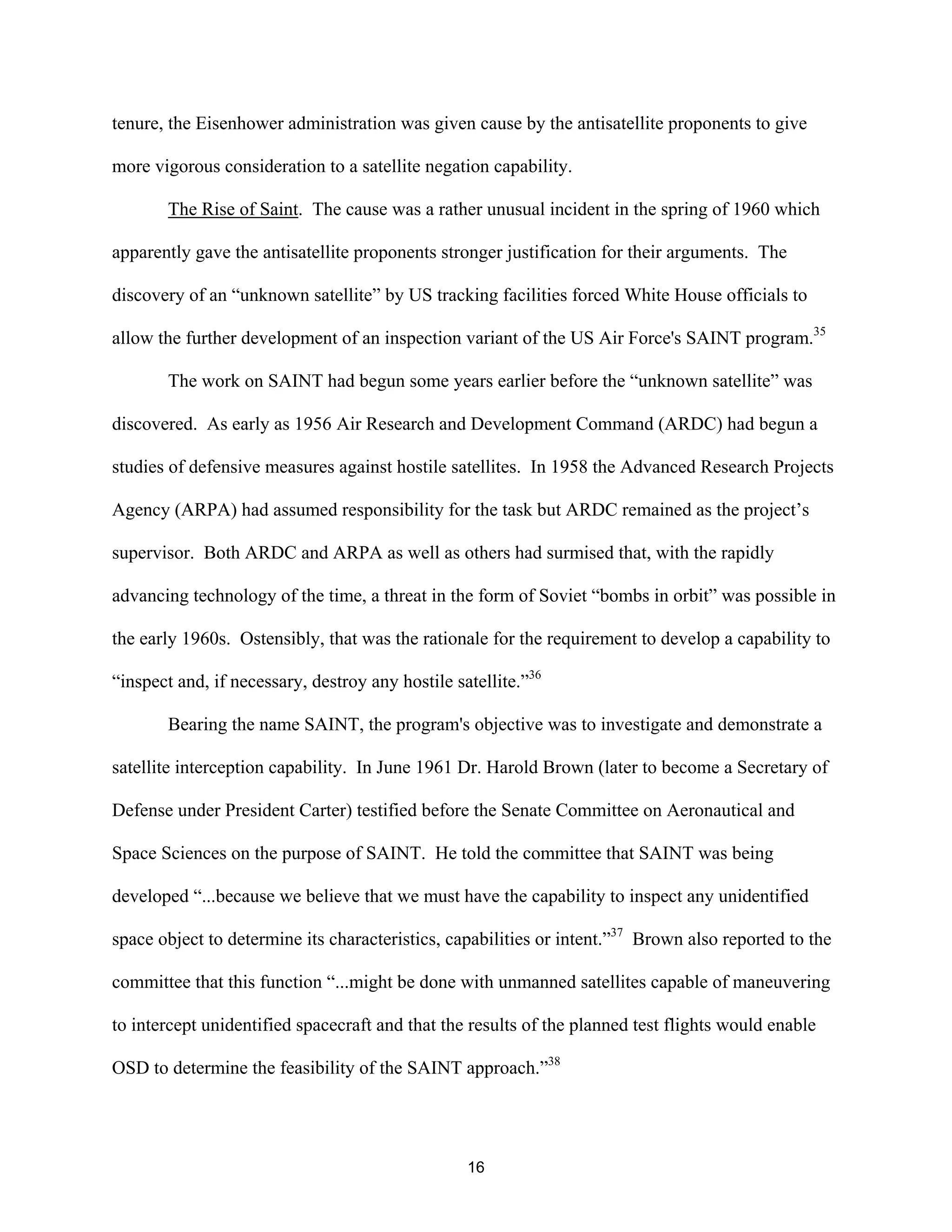
![Terminating SAINT. Before many of the contracts for developing SAINT were awarded,
the program was in trouble. Financial, technical, and political problems spelled doom for the
program. The Air Force’s inability to solely fund SAINT, as well as subsequent budget cuts in
the program, presented insurmountable financial problems. SAINT contractors, in spite of their
promises, faced a myriad of very difficult problems.39 President Eisenhower’s (and later
President Kennedy’s) “Space for Peace” platform presented perhaps the largest obstacle SAINT
had to overcome before it stood a chance for full scale development and deployment. Charles
Sheldon, who attended SAINT contractor briefings at the white House, remarked SAINT
suffered from “...severe conceptual problems--for example: could you get away with inspecting
another satellite without creating horrendous international problems?”40 Perhaps that is what
Eisenhower and Kennedy feared most--the political repercussions of “weaponizing” space.
Given these difficulties the Air Force canceled the SAINT program on 3 December 1962.
Hedging Bets. Nevertheless, Kennedy, like Eisenhower, was apparent1y still willing to
“hedge his bets” by authorizing the development of other: ASAT programs just in case they
might be needed to negate any unforeseen Soviet space threat. In February 1963, Marshal
Biriuzov, Chief of the Soviet Strategic Rocket Forces, stated in an interview: “It has now become
possible at a command from earth to launch missiles from satellites at any desired time and at
any point in the satellite trajectory.”41 Apparently the Defense Department had already
anticipated such an eventuality and had determined the need to develop the means to negate such
a threat should it arise. The previous month Secretary of Defense McNamara had testified before
Congress that “...the Soviet Union may now have or soon achieve the capability to place in orbit
bomb-carrying satellites...[and] we must make the necessary preparations now to counter it if it
does develop.”42 As it turns out, McNamara had instructed the US Army in May 1962 to
17](https://image.slidesharecdn.com/jlefyjqprmysojsst3xu-signature-da39021f777369fcb57be006ccacd597162829cea87ab234b0450f76e72e8bf3-poli-140825182222-phpapp01/75/A-us-asat-policy-for-a-multipolar-world-24-2048.jpg)
![develop an ASAT in the form of a modified Nike zeus.43 Perhaps as further insurance, the Air
Force was directed to ready an ASAT capability in the form of a Thor missile.44
The legacy of providing an insurance policy, or a contingency (hedging a bet), apparently
weighed heavily on the mind of the Kennedy administration, particularly so since the Russian
Biriuzov’s statement was made public. And how did McNamara explain the rationale behind the
requirement for two ASAT systems? He said “...the answer to that is that the Army system has
capabilities the Air Force system doesn’t have, so we consider it desirable to keep both.”45
McNamara declared that both systems achieved operational status during the summer of 1964.46
Reconsidering ASAT’s Need. Had the services succeeded in gaining an operational
antisatellite? On first inspection that may appear to be true. However, after further examination
it would appear that the policies of Eisenhower and Kennedy actually remained in tact--to pursue
the peaceful use of space while at the same time providing for an insurance policy in the form of
a contingency just in case some unforeseen threat did arise. A treaty banning weapons of mass
destruction from outer space was signed in 1963--and the nation deployed two ASAT systems
(both of which were actually of limited utility) in 1964. Now that weapons of mass destruction
had been banned from outer space (ostensibly the threat the ASAT systems were deployed to
counter), the only raison d’etre for the ASATs remained the negation of hostile satellites.47
However, McNamara ordered the cancellation of the Army’s Nike Zeus program in 1966.48 On
4 May 1970 Deputy Secretary of Defense Packard directed the Air Force to terminate the Thor
ASAT program it had deployed on Johnston Island. According to Air Force Historian Jacob
Neufeld, the rationale for canceling the Air Force ASAT program was because the system “...was
effective only against satellites operating in certain orbits and its use of nuclear warheads [as its
kill mechanism] created uncertainty as to when--if indeed ever--it might be used.”49
18](https://image.slidesharecdn.com/jlefyjqprmysojsst3xu-signature-da39021f777369fcb57be006ccacd597162829cea87ab234b0450f76e72e8bf3-poli-140825182222-phpapp01/75/A-us-asat-policy-for-a-multipolar-world-25-2048.jpg)
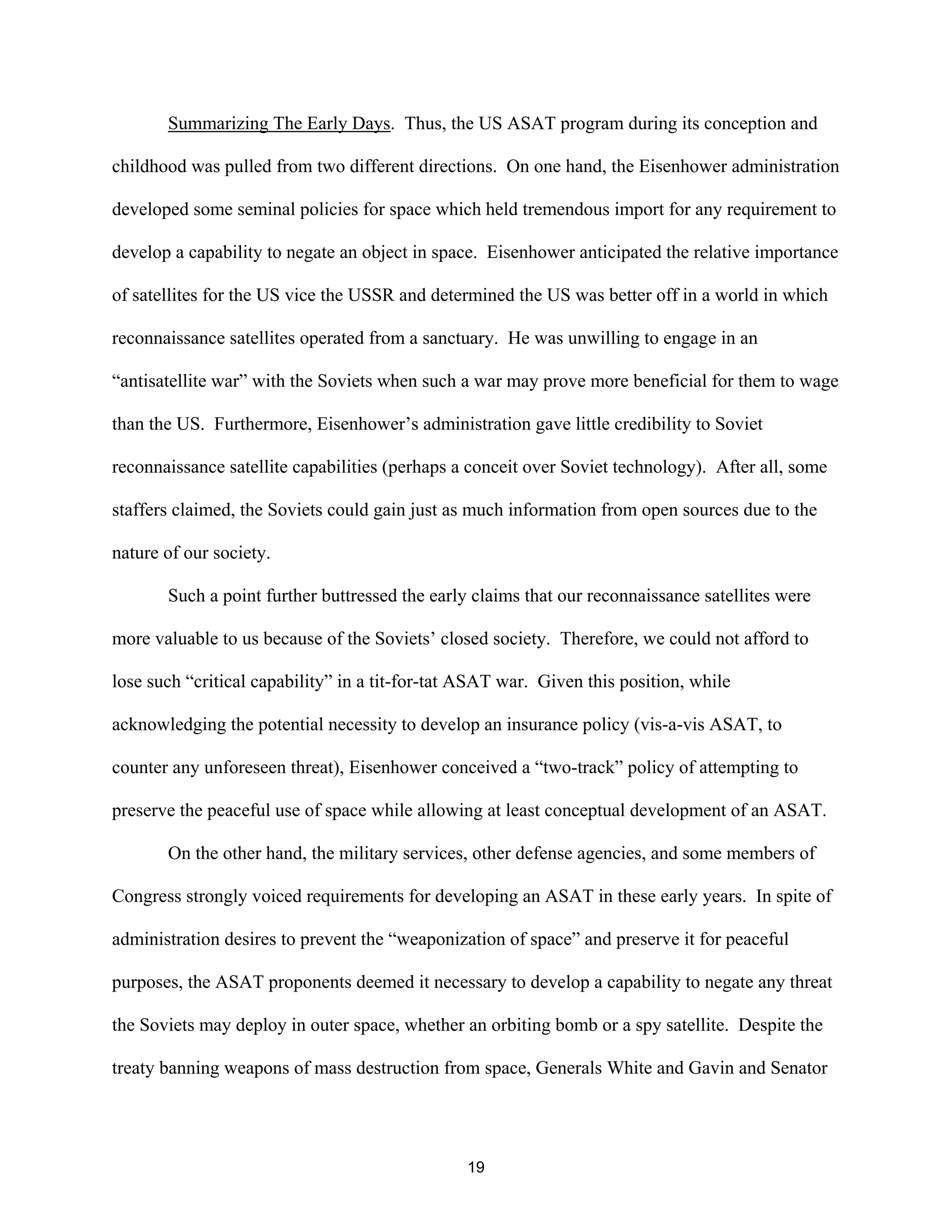
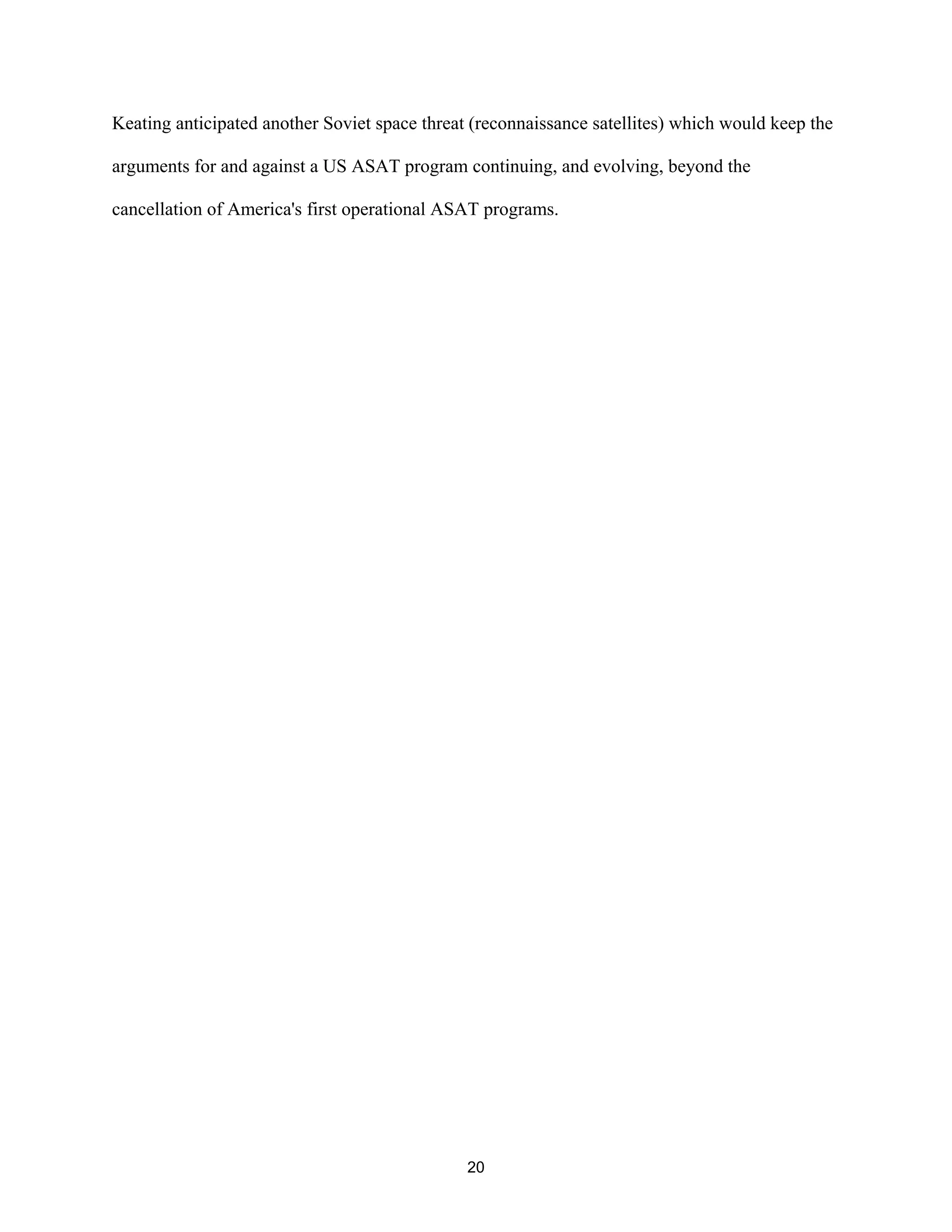


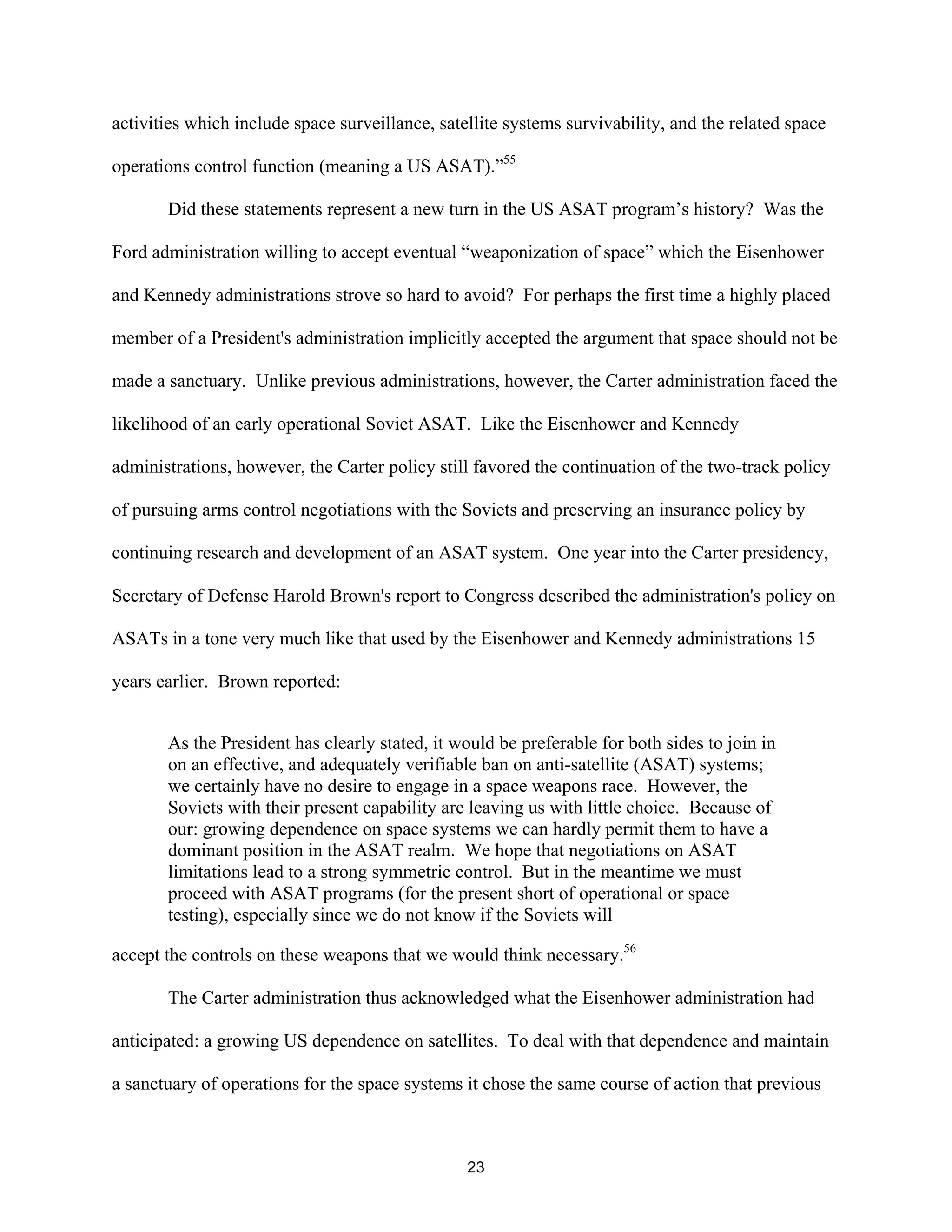
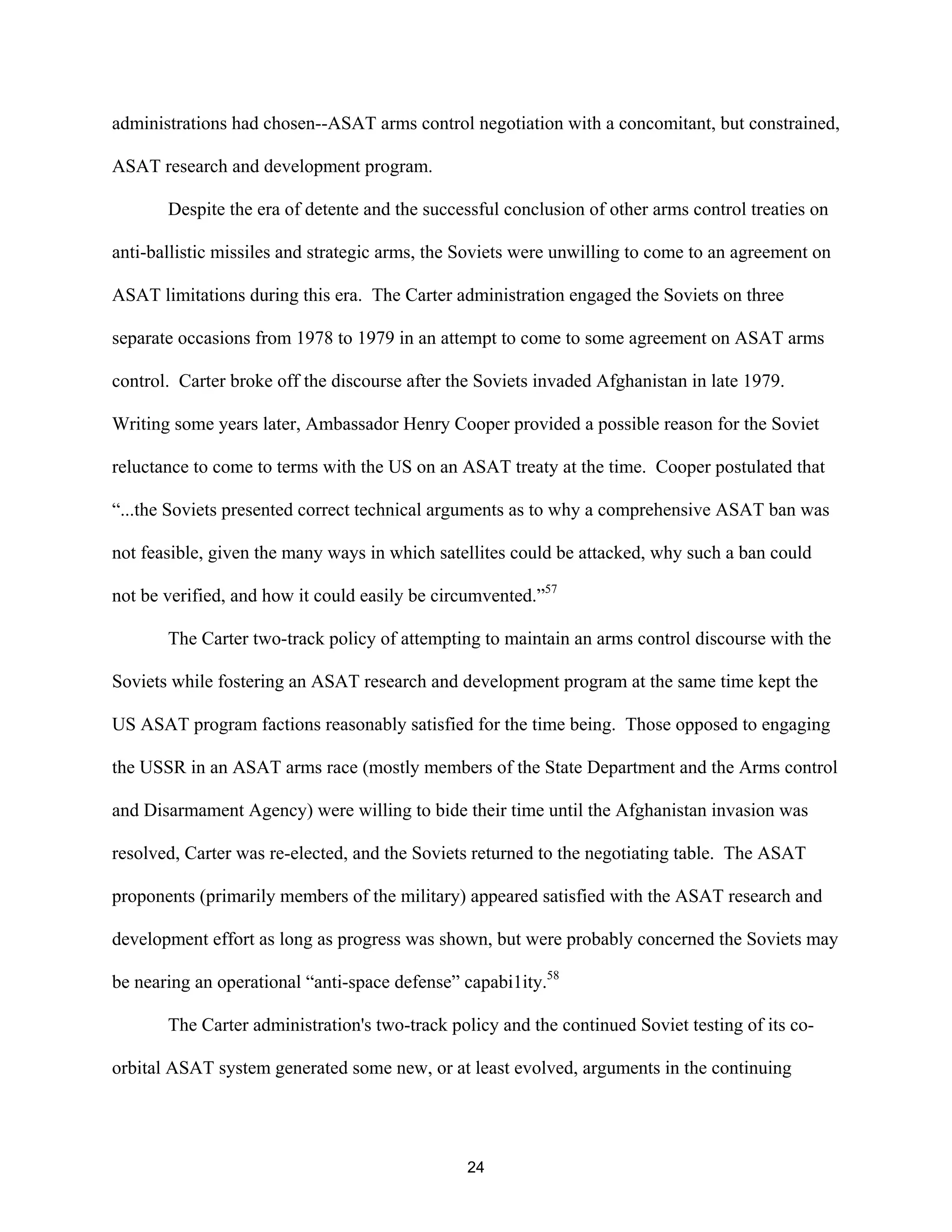
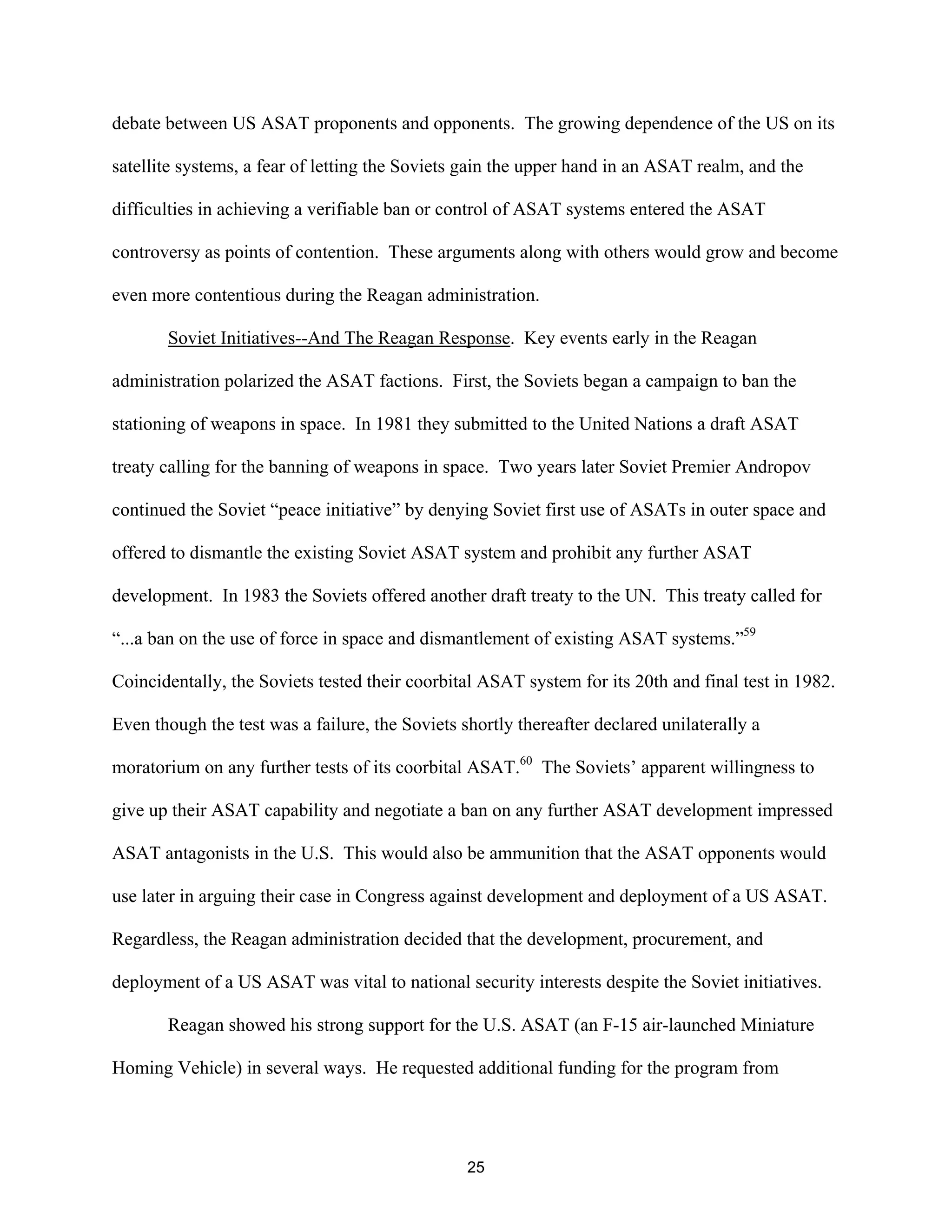

![space, ASAT opponents sought to constrain, and perhaps stop, the U.S. ASAT program and
force the administration to the bargaining table with the Soviets.
Soviet Satellites--How Threatening Are They? In the Appropriations hearings for FY
1984, Congress began investigating the Administration’s second requirement for an ASAT--to
negate “threatening” Soviet space systems which may be used to observe or target U.S. surface
forces. Dr. Cooper, Director of DARPA, testified that “[i]t was not until the use of Soviet low
earth orbiting satellites and their ocean surveillance capabilities that we began to feel those
spacecraft were so threatening to our forces in their ability to [monitor and target] our large
capital ships ...that we realized we probably should have an [ASAT] capability.”64 Cooper was
referring to the Soviet ELINT Ocean Reconnaissance satellites (EORSATs) and Radar Ocean
Reconnaissance Satellites (RORSATs). In his testimony he indicated it was relatively easy for
the Soviets to target a carrier with these systems. On the very same day, however, Vice Admiral
Gordon Nagler, the Navy’s Director, Command and Control, contradicted Cooper. He did not
agree with Cooper’s assessment that it was easy for RORSAT or EORSAT to detect a carrier
fleet and stated he had discussed in previous classified testimony how the Navy handles such
situations.65
In separate arms control hearings before Congress, another Navy admiral testified that the
Navy had already developed ways for dealing with Soviet overhead reconnaissance capabilities.
Admiral Noel Gayler indicated the Navy practiced the reduction of its communications and radar
transmissions to avoid satellite detection. A ship, he said, could also jam a radar satellite or
deceive it and render it ineffective.66 It is unclear why the Navy at first appeared to attribute so
little concern over the EORSAT and RORSAT threat, particularly since this was one of the
prime reasons the Reagan administration used to justify the requirement for an ASAT. Since the
27](https://image.slidesharecdn.com/jlefyjqprmysojsst3xu-signature-da39021f777369fcb57be006ccacd597162829cea87ab234b0450f76e72e8bf3-poli-140825182222-phpapp01/75/A-us-asat-policy-for-a-multipolar-world-34-2048.jpg)
![ASAT was an Air Force program, carried and launched by an Air Force F-15, perhaps explains
the Navy’s less than lukewarm support of the program.
Yet another admiral supported and corroborated Nagler’s and Gayler’s testimonies.
Congress heard additional testimony that Navy fleet dispersal patterns and ship alignments could
thwart Soviet satellite detection.61 Vice Admiral Henry Mustin related how the US Navy was
able to accomplish such a feat in a 1985 NATO Ocean Safari exercise:
When we came across the Atlantic we disappeared from the face of the earth, as
far as the Soviets were concerned, same place off Halifax, and only resurfaced
where we are today (same 650km west of Hebrides) because we felt like it and I
can tell you they were going bananas trying to find us and some of the comments
they made were very interesting.68
Congress’ Office of Technology Assessment (OTA) provided another assessment of the
Soviet satellite targeting capability in a 1985 report. The Office stated the Soviet EORSAT and
RORSAT systems posed “…only a limited threat to U.S. and allied surface fleets...[because] a
ship would be exposed to observation only intermittently [due to the satellites’ orbital
configurations and observation swaths] and might successfully evade the satellite [s].”69 OTA’s
report did observe that the peacetime configuration for the EORSAT and RORSAT (only 1 or 2
of each class on orbit at one time) made evading the satellites simpler, but increased numbers of
the satellites on orbit launched during a crisis or conflict could make evasion a much more
difficult task. OTA also allowed for the possible growing sophistication and proliferation of
more satellites by both sides which might increase the incentive for the U.S. and the USSR to
maintain and deploy ASAT weapons.70 Indeed, during the mid-1980s the Navy became more
concerned with Soviet ocean reconnaissance capabilities and began voicing stronger support for
the U.S. ASAT program. Gaining stronger Navy support for the ASAT was perhaps necessary
for the administration since Congress was beginning to become more resistant to the
28](https://image.slidesharecdn.com/jlefyjqprmysojsst3xu-signature-da39021f777369fcb57be006ccacd597162829cea87ab234b0450f76e72e8bf3-poli-140825182222-phpapp01/75/A-us-asat-policy-for-a-multipolar-world-35-2048.jpg)
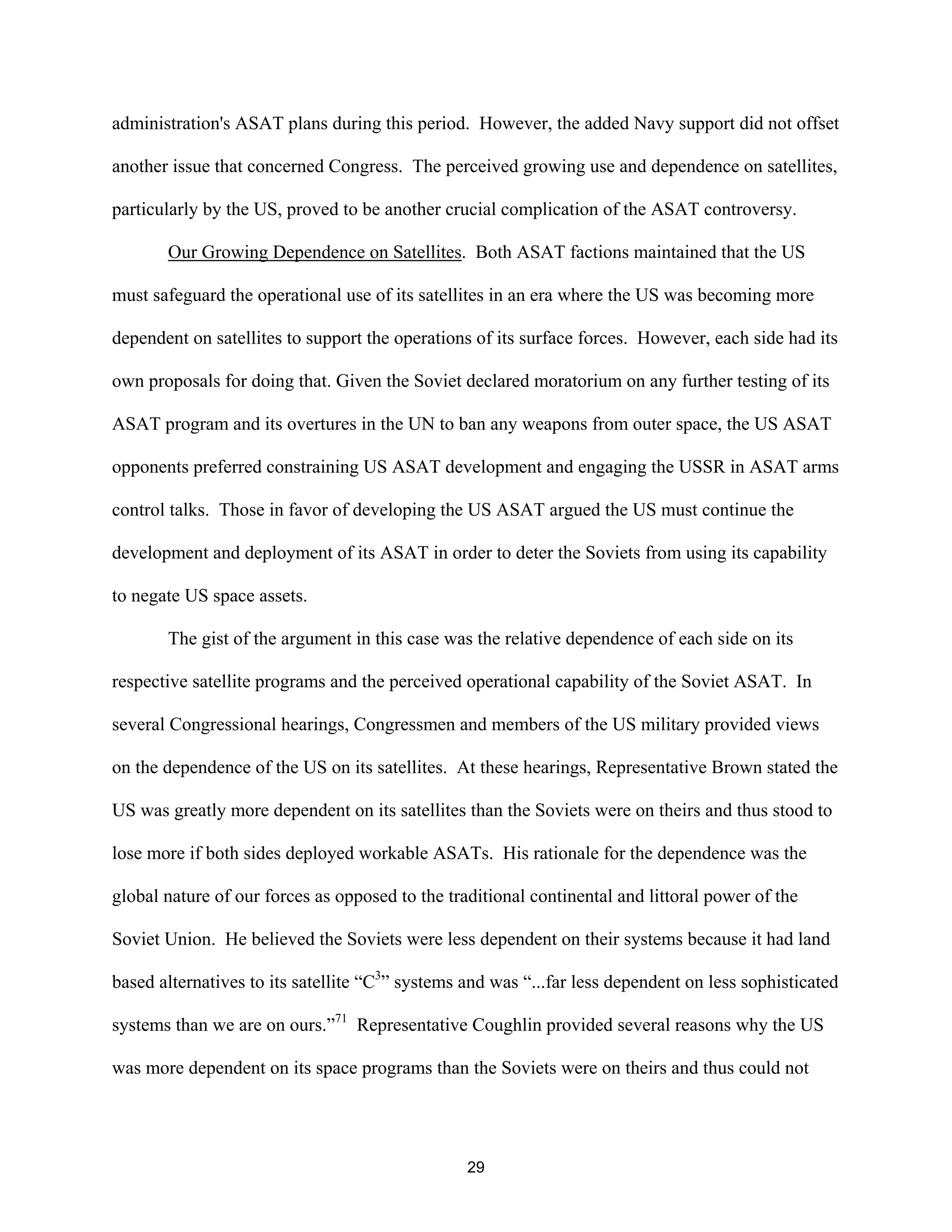
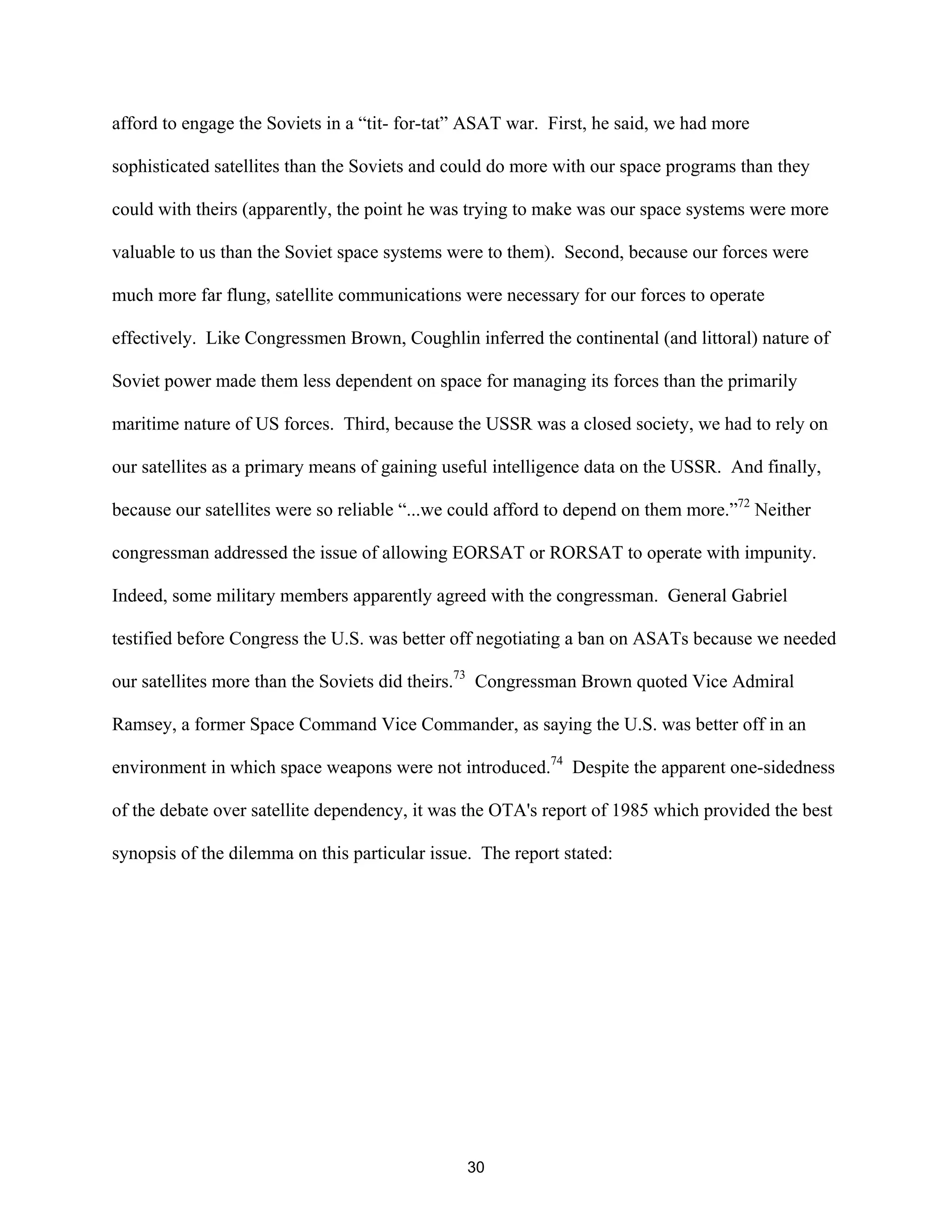
![In choosing between ASAT weapon development and arms control, one wishes to
pursue that course which makes the greater contribution to U.S. national security.
This is often characterized as a choice between developing a capability to destroy
Soviet satellites while assuming U.S. satellites will also be at risk, or protecting
U.S. satellites to same extent through arms control while forfeiting effective
ASAT weapons. The better choice could, in principle, be identified by comparing
the utility which the United States expects to derive from its military satellites
with the disutility which the United States would expect to suffer from Soviet
MILSATs [military satellites] during a conflict. Such a comparison--although
possible in principle--is made exceedingly difficult by the number of conflict
scenarios which must be considered and by the lack of consensus or official
declaration about the relative likelihood and undesirability of each scenario.
Congress faced a tough dilemma. Should the nation embark on negotiations with the
USSR to ban weapons in space and expect such an agreement could be verified? On the other
hand, could the nation afford to deploy an ASAT system and use it against Soviet space systems
given the Soviets would use theirs in response, with the Soviets perhaps having the end-game
advantage due to our supposedly greater dependence on space systems? Essentially, it was a
matter of which side would have more to gain or lose in an ASAT war with the Soviets. If
deterrence was based on the “fear of consequences”, then did we have more to fear than the
Soviets if either side escalated a surface conflict to space by taking out the other side’s satellites?
Although it continued to hear arguments both for and against a U.S. ASAT through the 1980s,
Congress made its choice--an ASAT-free world appeared safer than one with such a weapon
system.
Congress Prevails--Constraining the US ASAT. Despite going along with the Reagan
administration in its earlier years and granting appropriations for the F-15 ASAT program equal
to the administration’s request, Congress in the mid-1980s began constraining the U.S. ASAT
program. For the FY 1986 appropriation procurement money was slashed significantly; in FYs
1987 and 1988 Congress denied procurement money completely. On December 19,1985 a
31](https://image.slidesharecdn.com/jlefyjqprmysojsst3xu-signature-da39021f777369fcb57be006ccacd597162829cea87ab234b0450f76e72e8bf3-poli-140825182222-phpapp01/75/A-us-asat-policy-for-a-multipolar-world-38-2048.jpg)
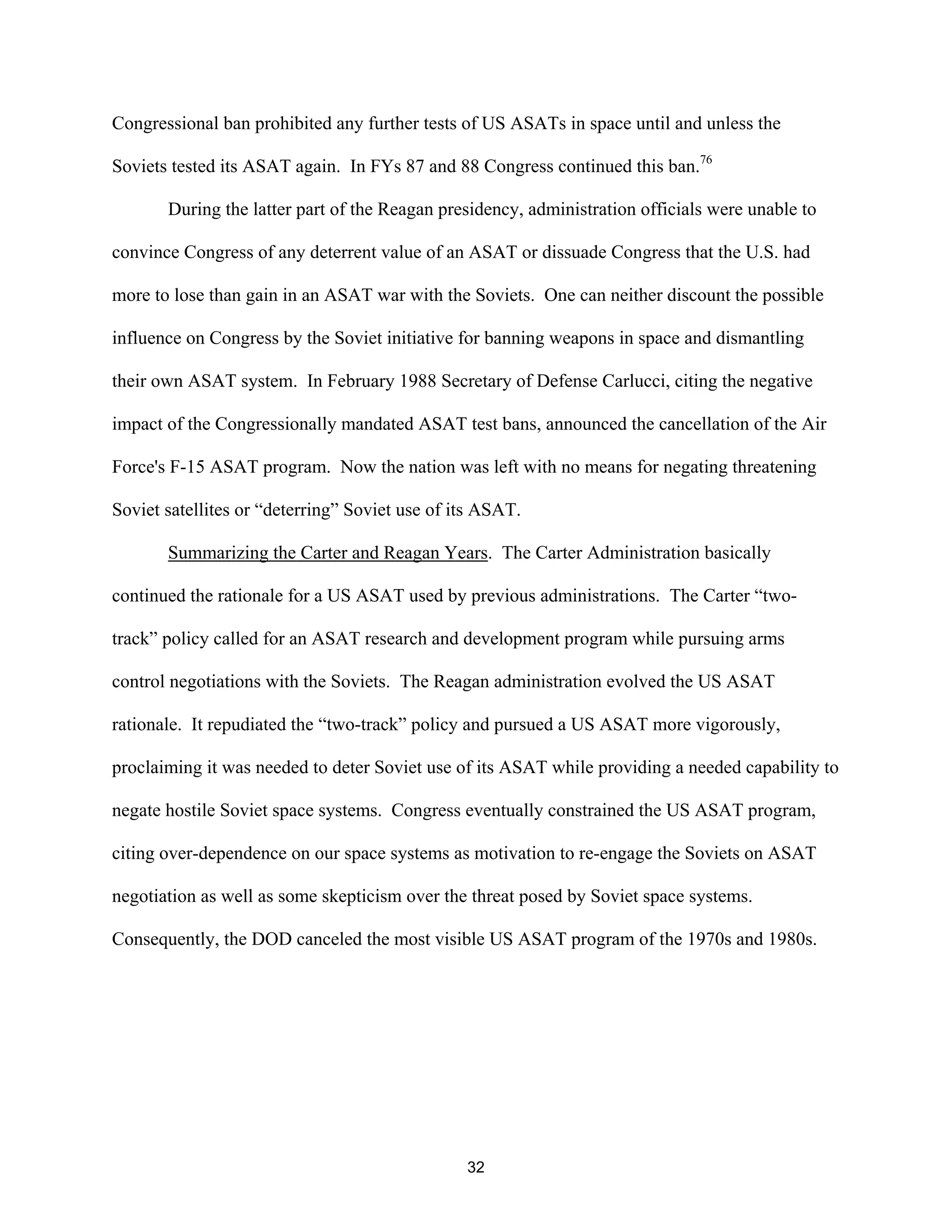
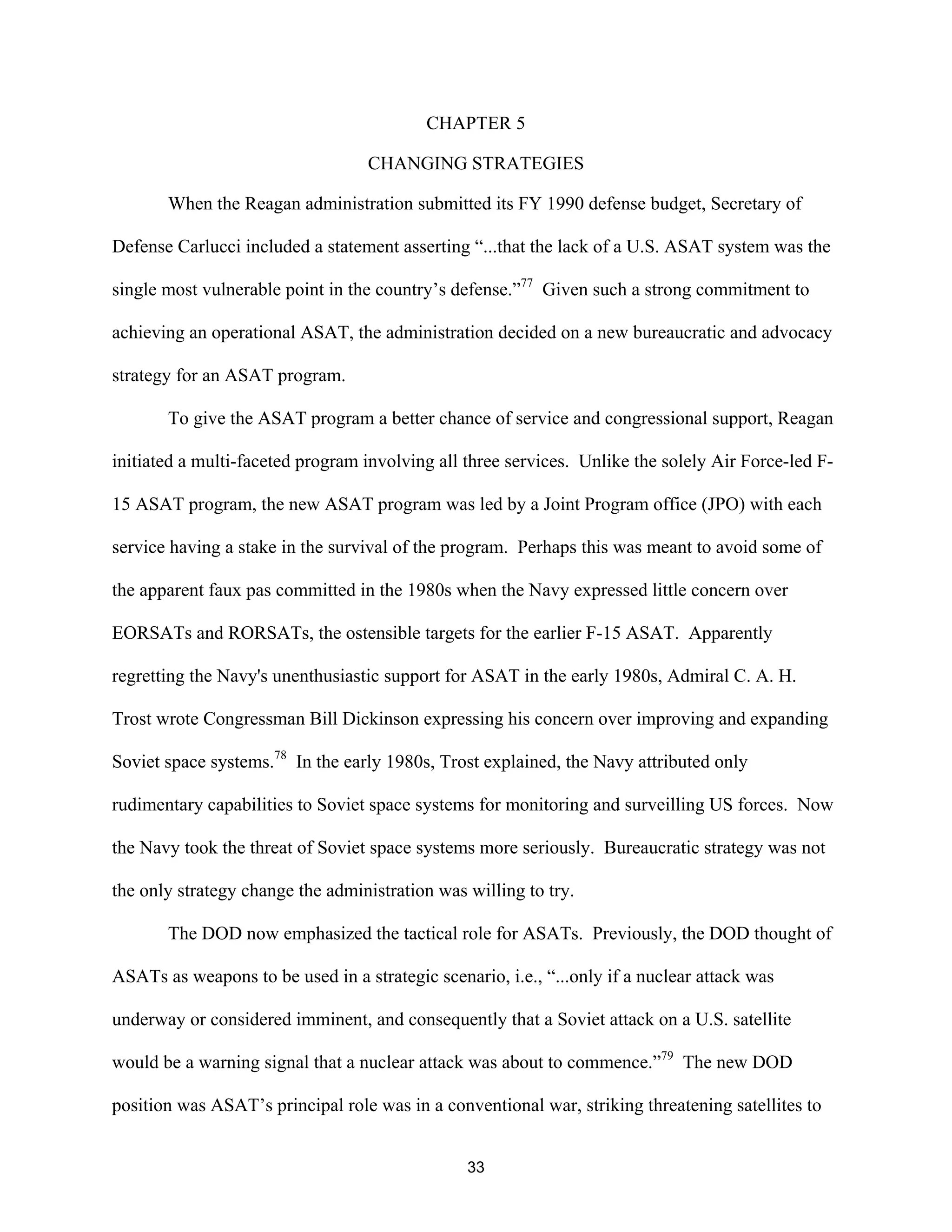
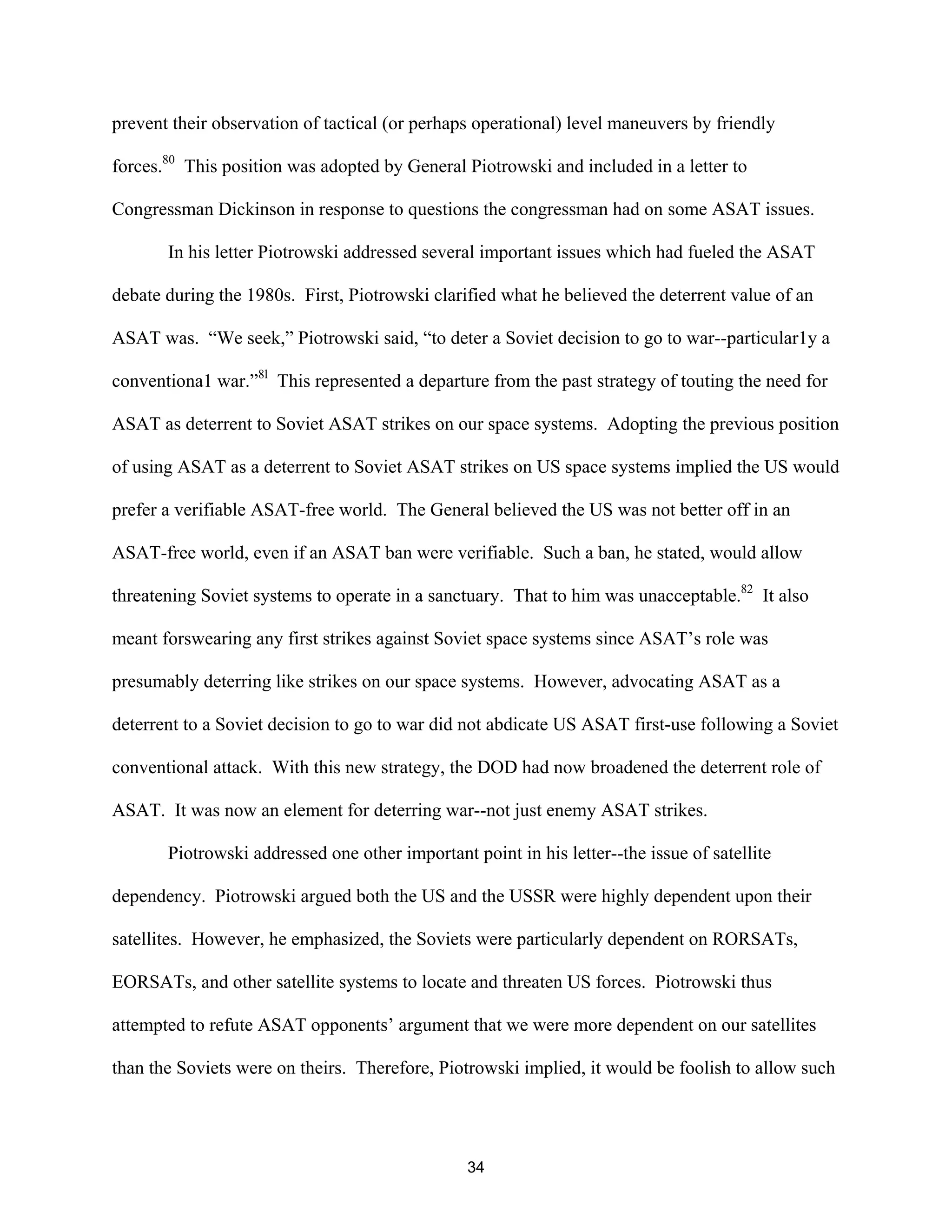
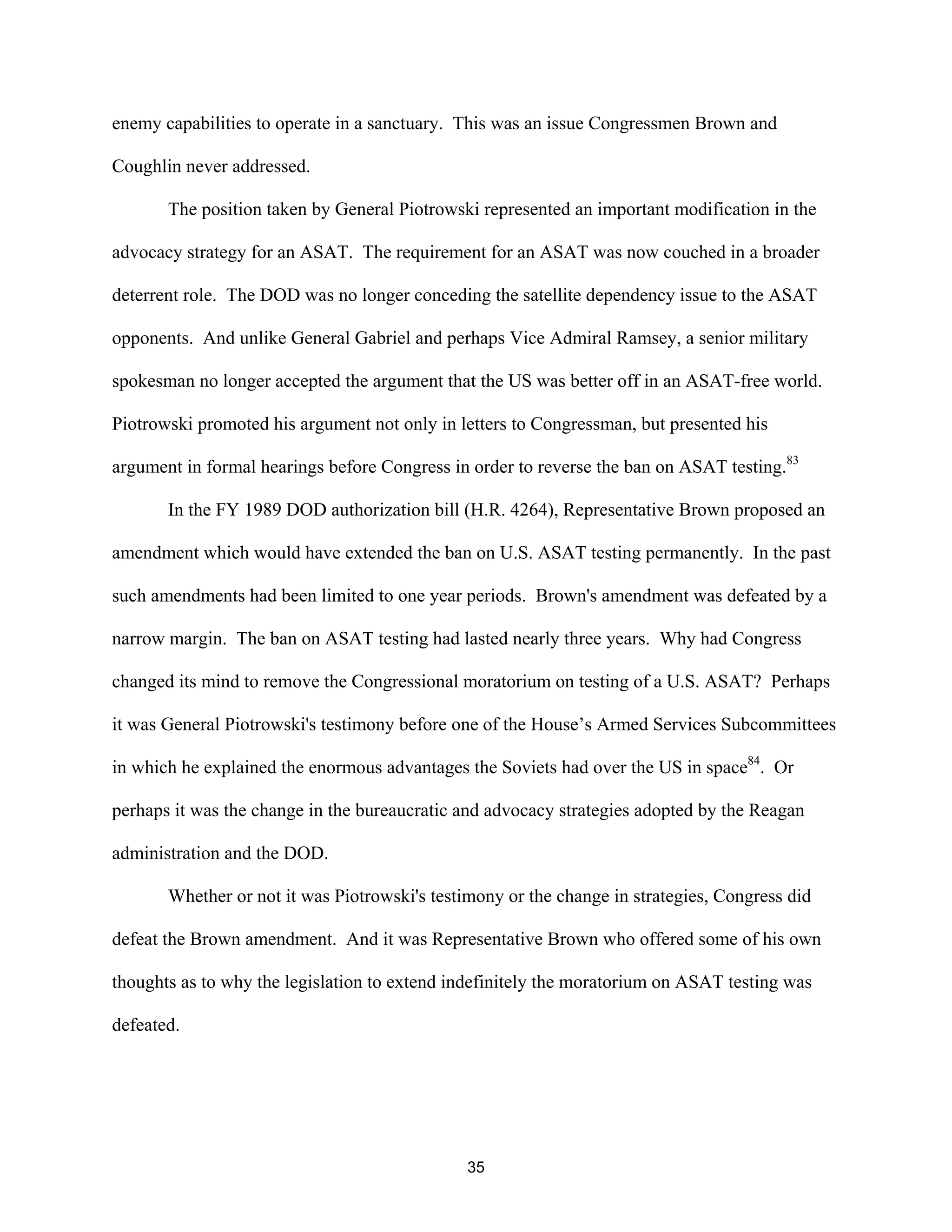
![Initially, Brown offered three explanations for the defeat of the Brown-Coughlin
amendment. Perhaps, he thought, some Congressional members were afraid of the “permanent
nature of the testing restriction.” Or perhaps some of these members “...felt that passage of the
amendment was not necessary, because of the cancellation of the [F-15] program.” Or a third
explanation was that “...these Members felt that it was no longer good arms control policy, since
the President was now a vigorous proponent of arms control and could be depended upon to seek
a reasonable ASAT arms control agreement with the Soviets, without further restrictions by the
Congress.”85 Despite these reasons, Brown asserted that a strong effort by the white House, the
JCS, and the Air Force helped to defeat the Brown-Coughlin amendment. At the heart of this
vigorous effort, Brown stated, was a “...high and rapidly increasing priority being given to the
development of a warfighting capabi1ity in space.”86
Perhaps Brown’s final assessment was correct. It would appear that Piotrowski and the
DOD did indeed think ASAT was needed not just for its qualities as an element of the overall
deterrent posture, but as a warfighting tool itself should deterrence fail.
It could certainly be asserted, at least in the minds of the ASAT advocates, that the
requirement for a US ASAT had reached adulthood. But no sooner had the US ASAT program
been revitalized when the threat environment began to radically change.
36](https://image.slidesharecdn.com/jlefyjqprmysojsst3xu-signature-da39021f777369fcb57be006ccacd597162829cea87ab234b0450f76e72e8bf3-poli-140825182222-phpapp01/75/A-us-asat-policy-for-a-multipolar-world-43-2048.jpg)
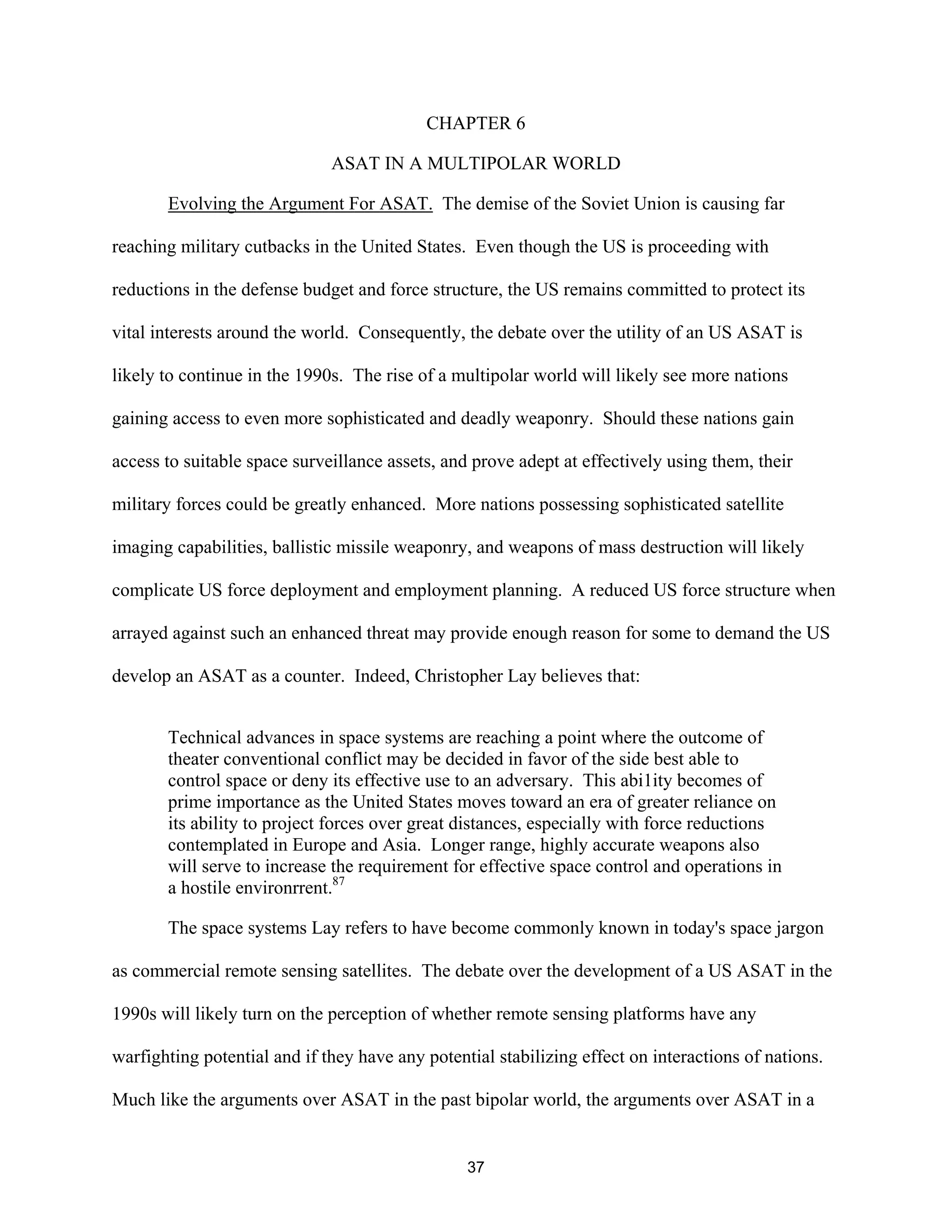
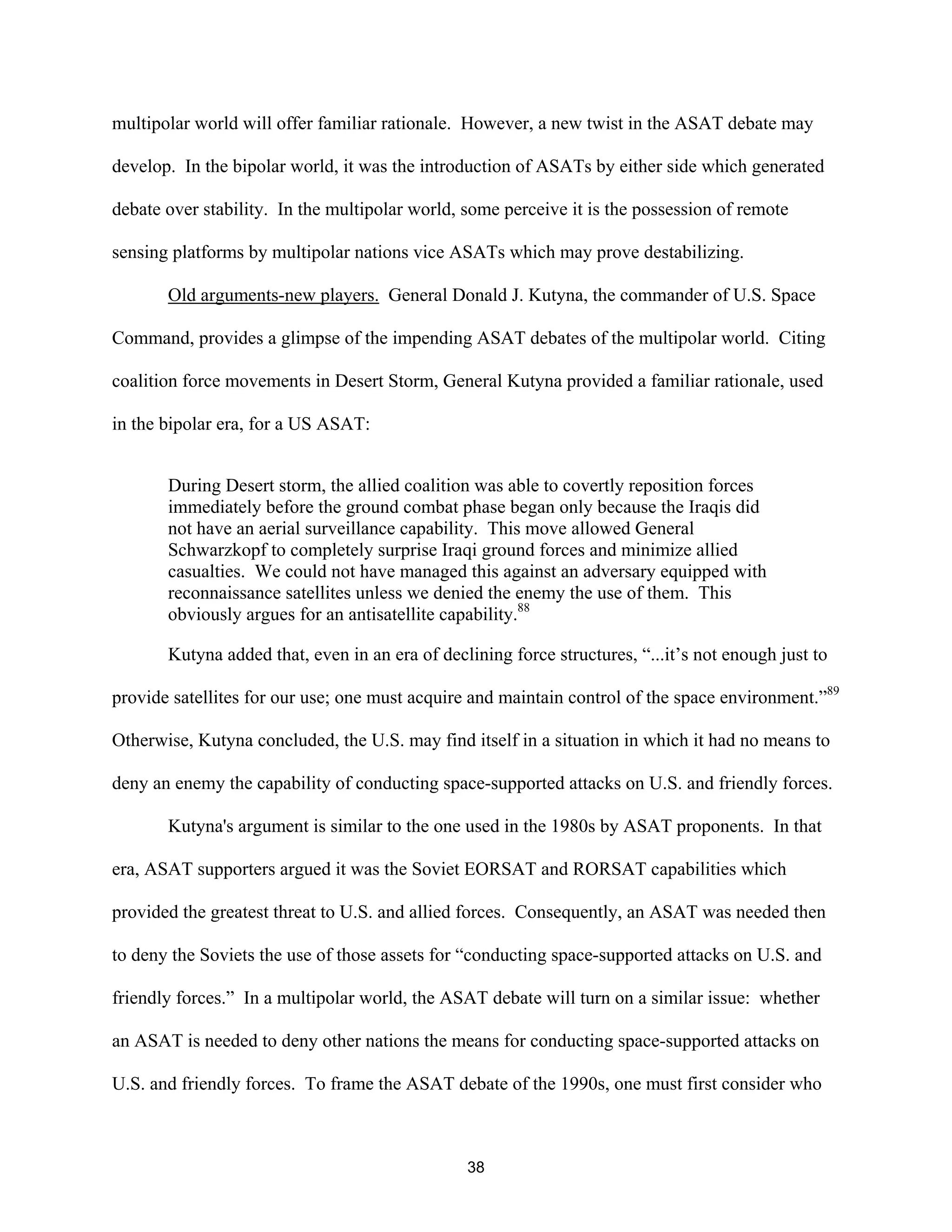
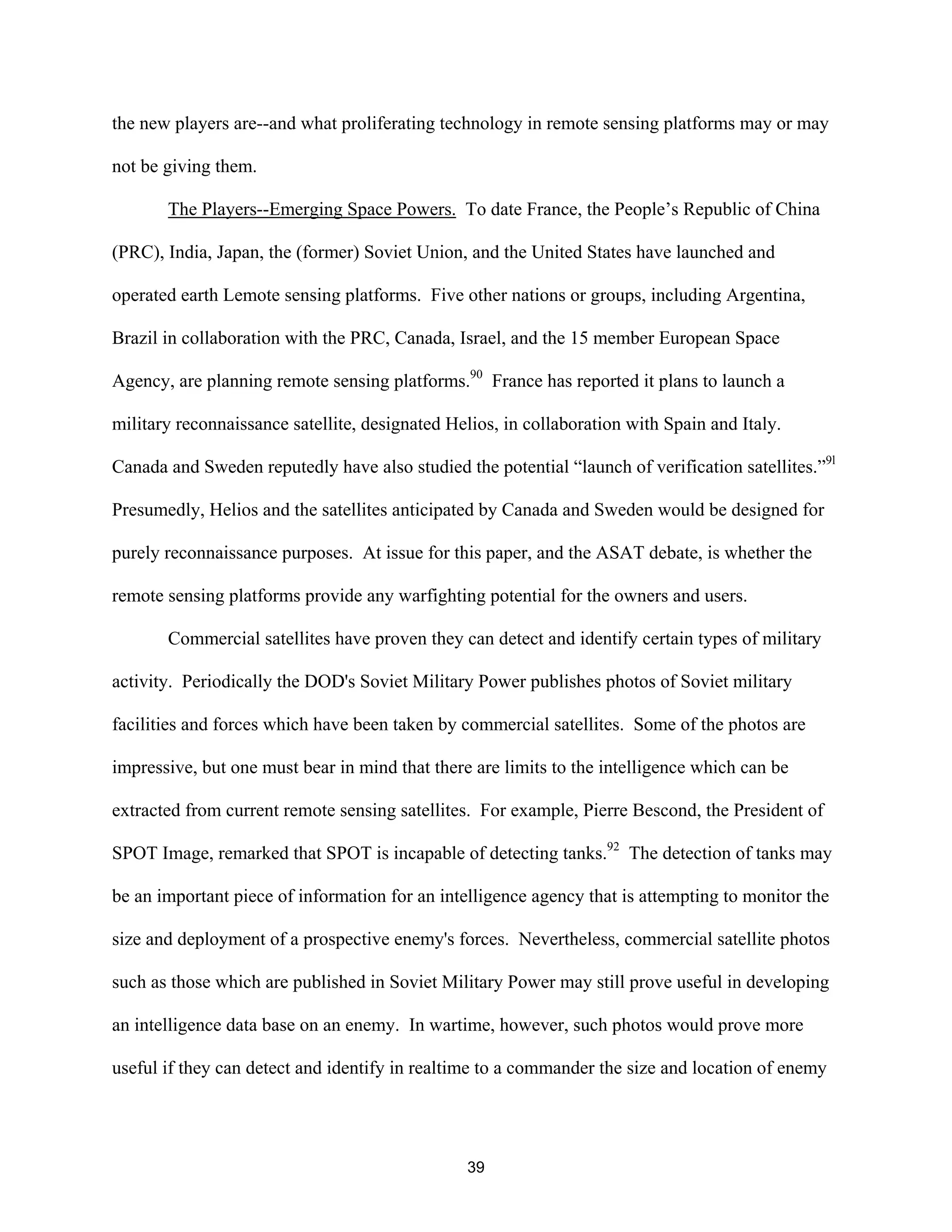
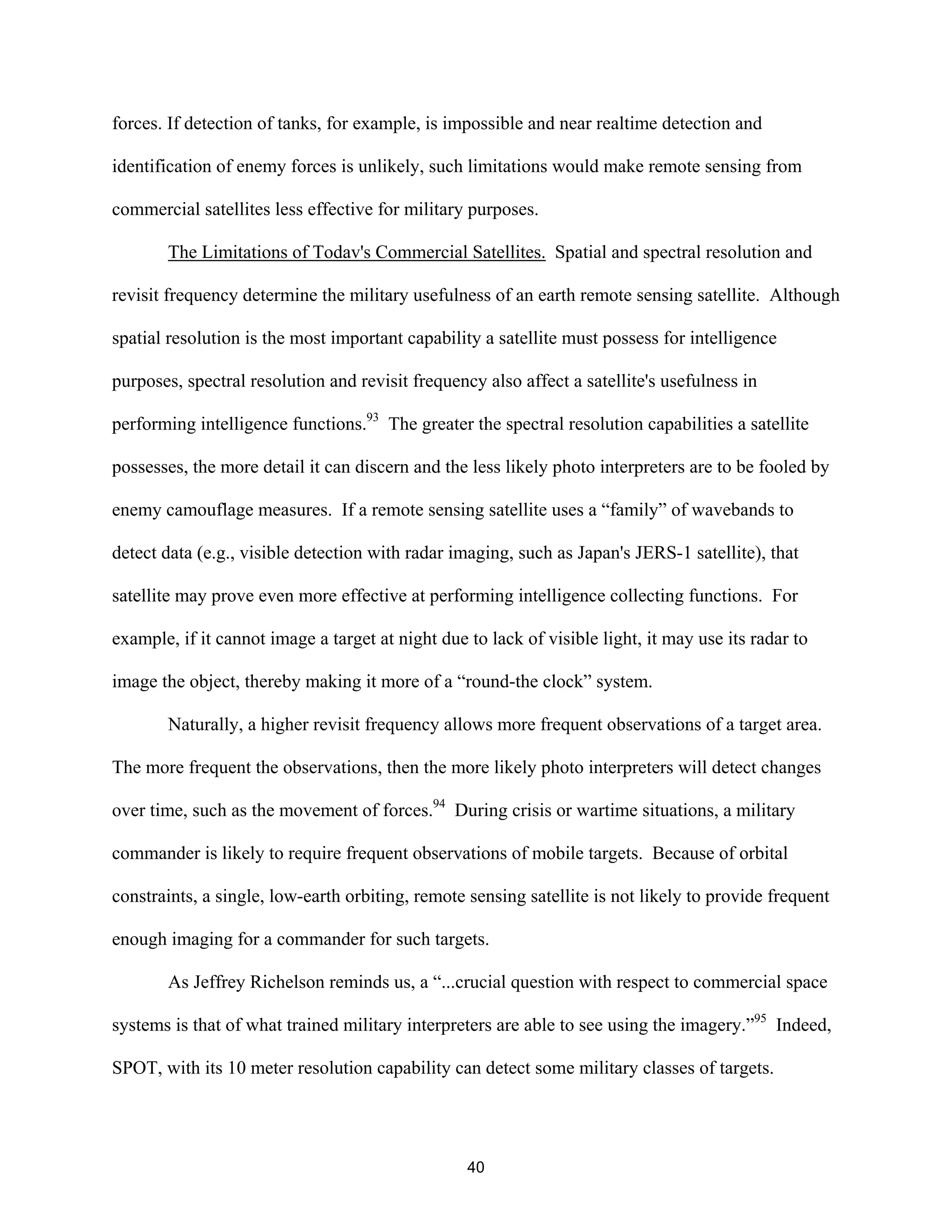
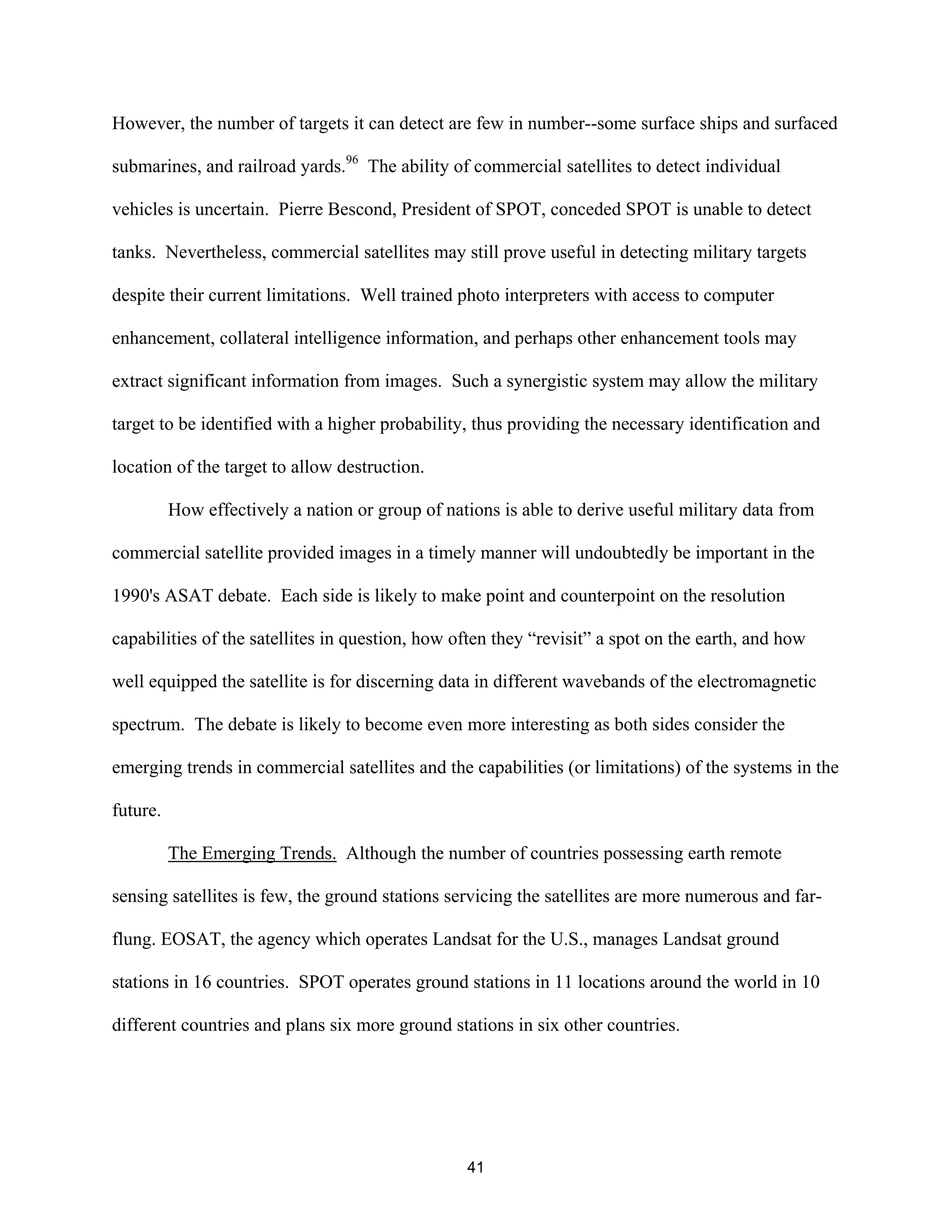

![Announced by the Soviets as an earth resources imaging platform, the Almaz-1 could be used to
image through clouds and in daylight or nighttime conditions. Having a resolution estimated in
the 15-30 meter range, its resolution capability is slightly less than that of SPOT with its 10
meter resolution capability. Yet Almaz-1 could penetrate clouds, water cover, and darkness--
SPOT could not.102 Aviation Week & Space Technology reported the Soviet satellite may even
have the capability to detect submerged submarines.103 If its resolution capabilities were
superior to that of SPOT, as the Aviation Week article implies, Almaz-1 might prove more
useful for military purposes than SPOT.
Almaz-1 uses synthetic aperture radar (SAR) to perform its imaging mission. Indeed, if
properly equipped, a SAR imaging satellite can provide superior resolution making the platform
very valuable for a military reconnaissance mission.104 The European Space Agency (ESA),
Japan, and Canada are planning advanced SAR remote sensing satellites for launch in the early
1990s. The Soviets have already announced its intention to sell the services of the Almaz-1
commercially. One would expect that the ESA, Japan, and Canada might do likewise with their
SAR equipped satellites. Even though trends might indicate that more nations potentially stand to
gain from the proliferation of remote sensing satellites, the satellites alone do not make a military
effective system. Satellites alone represent only a piece to the puzzle of satellite image
processing.
Technology Does Not a System Make. Few nations have so far developed completely
indigenous military or commercial space systems. Space systems themselves include inter alia
the satellite, data processing facilities, launch sites, launcher and satellite production facilities.
Jeffrey Richelson concludes that a nation, before embarking on developing its own military or
commercial space system must consider [t]he potential drawbacks of building a national system
43](https://image.slidesharecdn.com/jlefyjqprmysojsst3xu-signature-da39021f777369fcb57be006ccacd597162829cea87ab234b0450f76e72e8bf3-poli-140825182222-phpapp01/75/A-us-asat-policy-for-a-multipolar-world-50-2048.jpg)
![[which] would include absolute cost and cost efficiency. A several-billion-dollar investment
would be required to establish a launch site, build the launch vehicles, develop the satellite,
construct a ground control station or network, purchase the necessary computers and imagery
enhancement software, and maintain a sufficiently large set of trained imagery interpreters.
Additionally, it would probably be considered highly desirable, if not mandatory, to invest
resources to ensure secure transmission of the data--especially given the large number of nations
that operate ground stations for the interception of satellite communications.
If a nation did consider the absolute cost to be affordable, it may yet determine such an
intelligence gathering capability ineffective. For example, if Israel had acquired a dedicated
military space system just to provide information for Entebbe-like raids, many would consider
such a multi-billion dollar investment foolish if other less costly intelligence gathering services
could have proven just as effective.l06 However, a nation may decide it can gain satellite
imaging at a more cost effective rate by entering into a client relationship with a nation that has
expended the investment to develop a complete space system.
EOSAT and the SPOT organization currently operate on a contractual basis with nations
operating ground stations for these programs. By sharing in construction and operating costs and
paying a yearly fee, a nation operating a ground station in support of Landsat and SPOT may
have access to the data provided by the satellites. Such an arrangement proves to be less costly
than shouldering alone the costs for developing a commercial space system.l07
However, there are drawbacks to such relationships. In order to take advantage of this
arrangement, the station-providing nations may have to develop their own photo-interpreters.
Indeed, many are doing just that. One analyst reports that remote sensing skills are taught in
several educational institutions in the US and western Europe. These institutions offer training
44](https://image.slidesharecdn.com/jlefyjqprmysojsst3xu-signature-da39021f777369fcb57be006ccacd597162829cea87ab234b0450f76e72e8bf3-poli-140825182222-phpapp01/75/A-us-asat-policy-for-a-multipolar-world-51-2048.jpg)
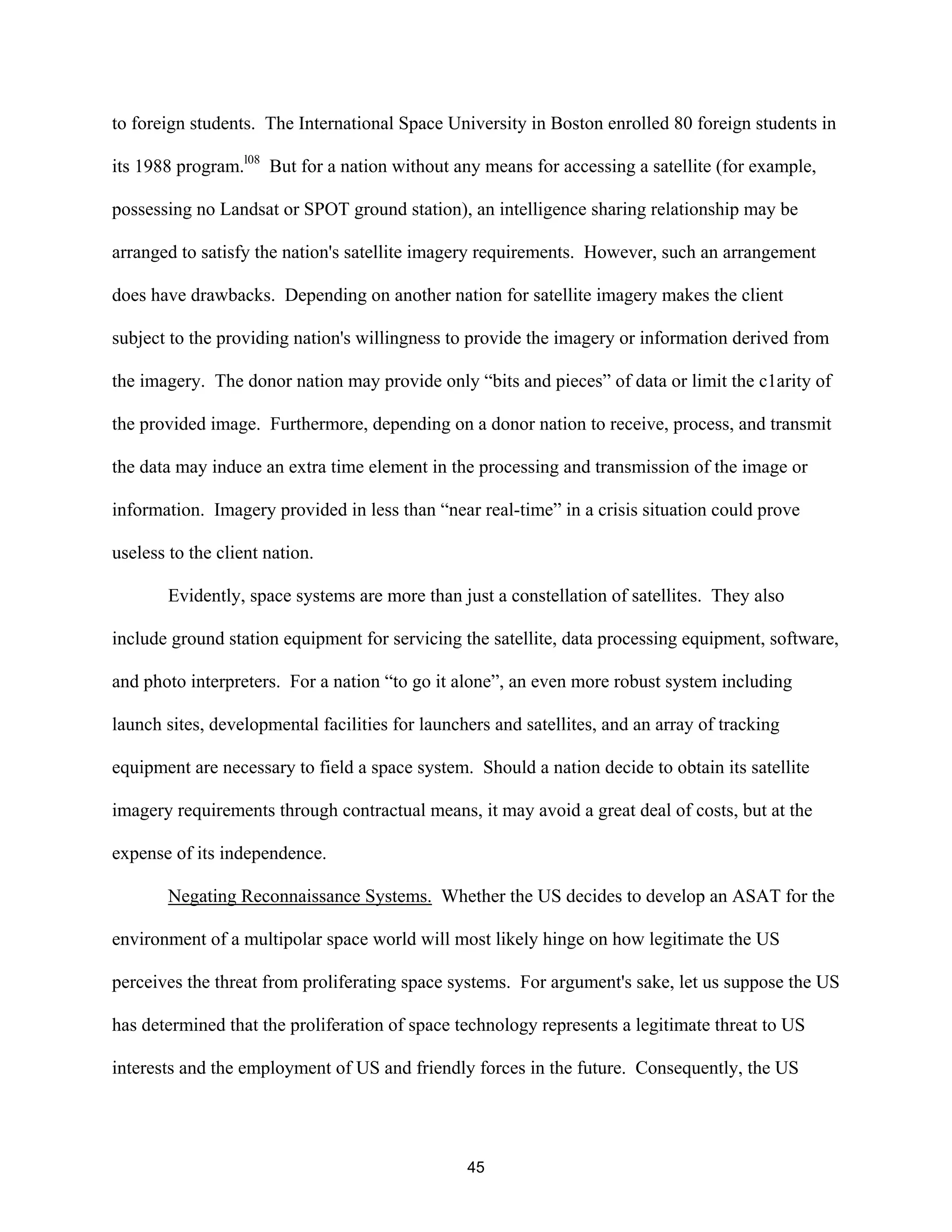
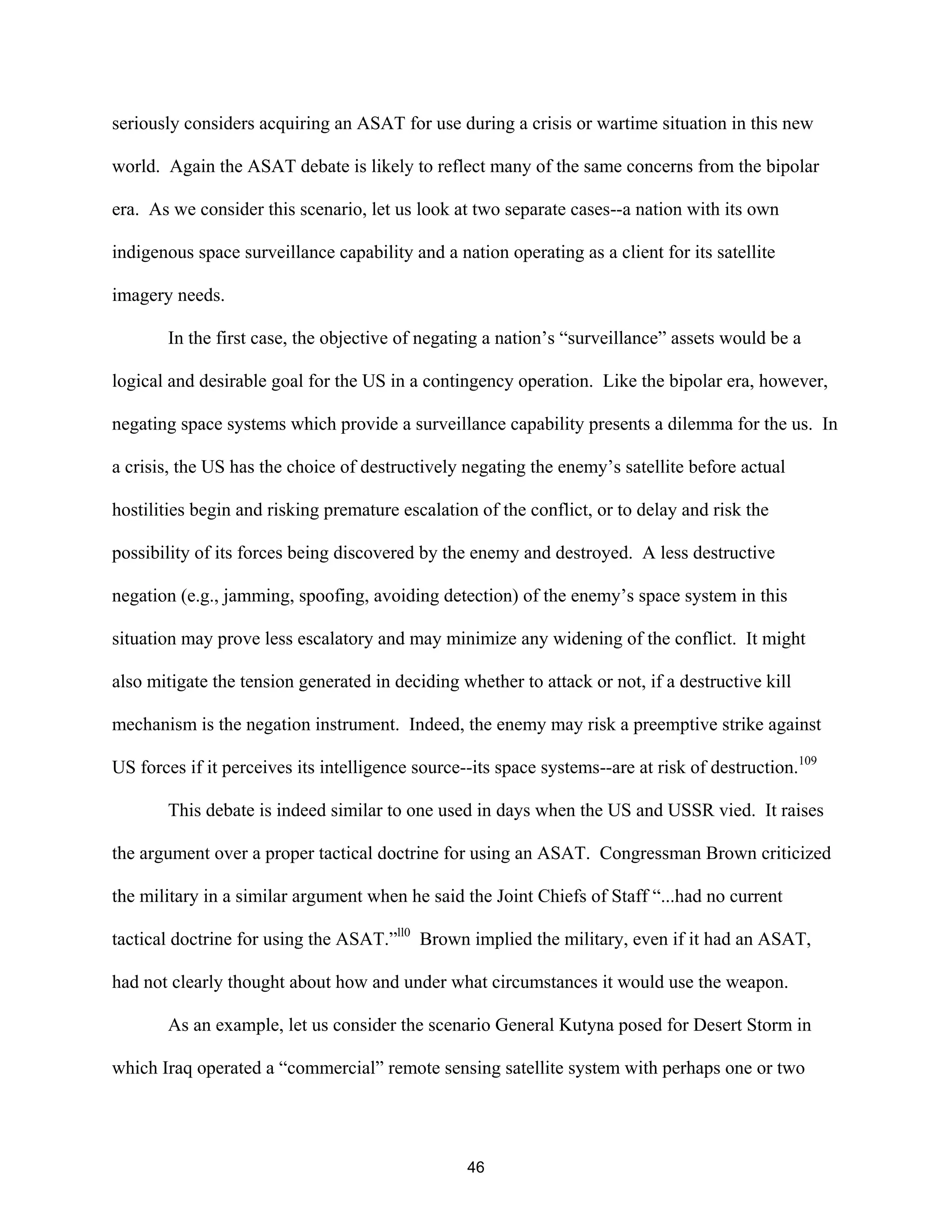
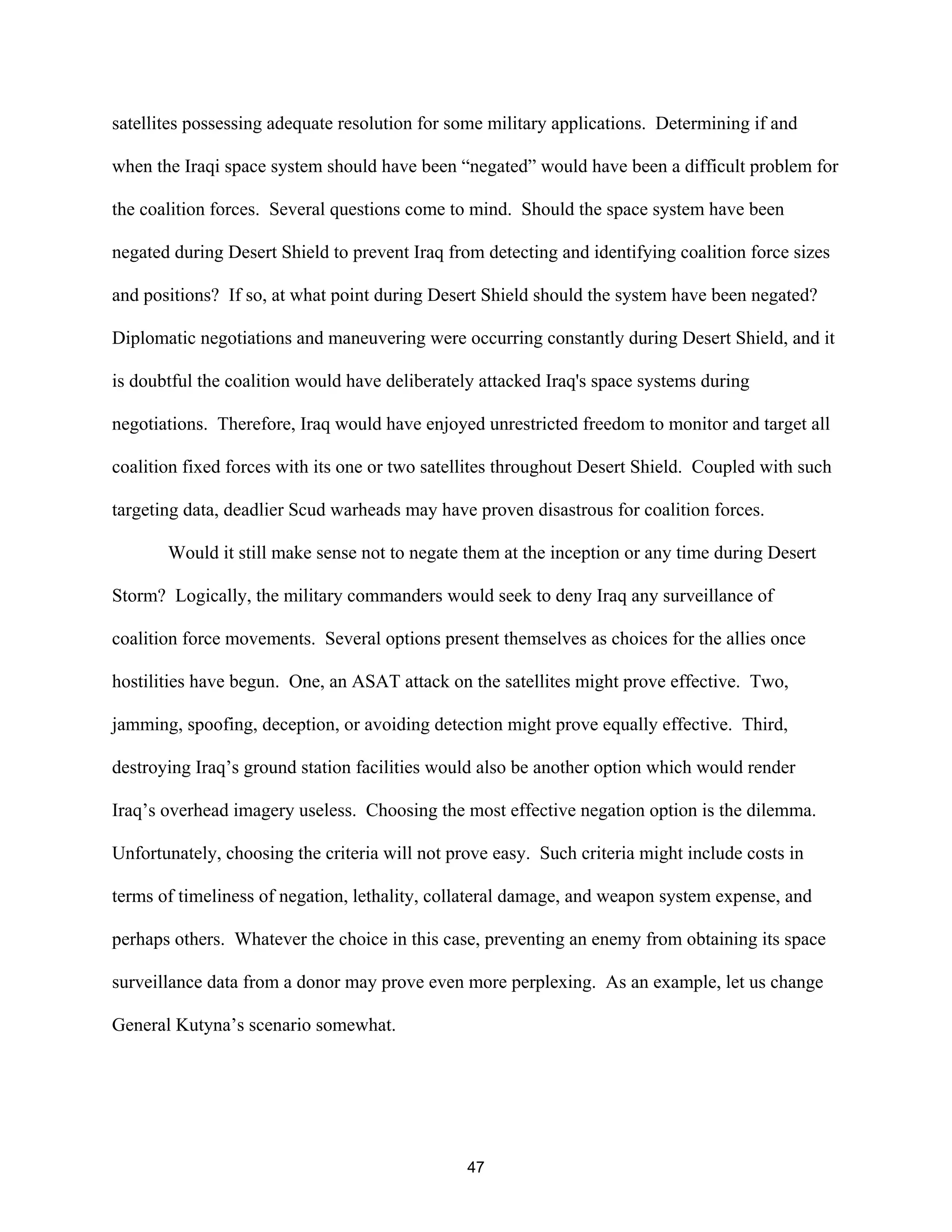
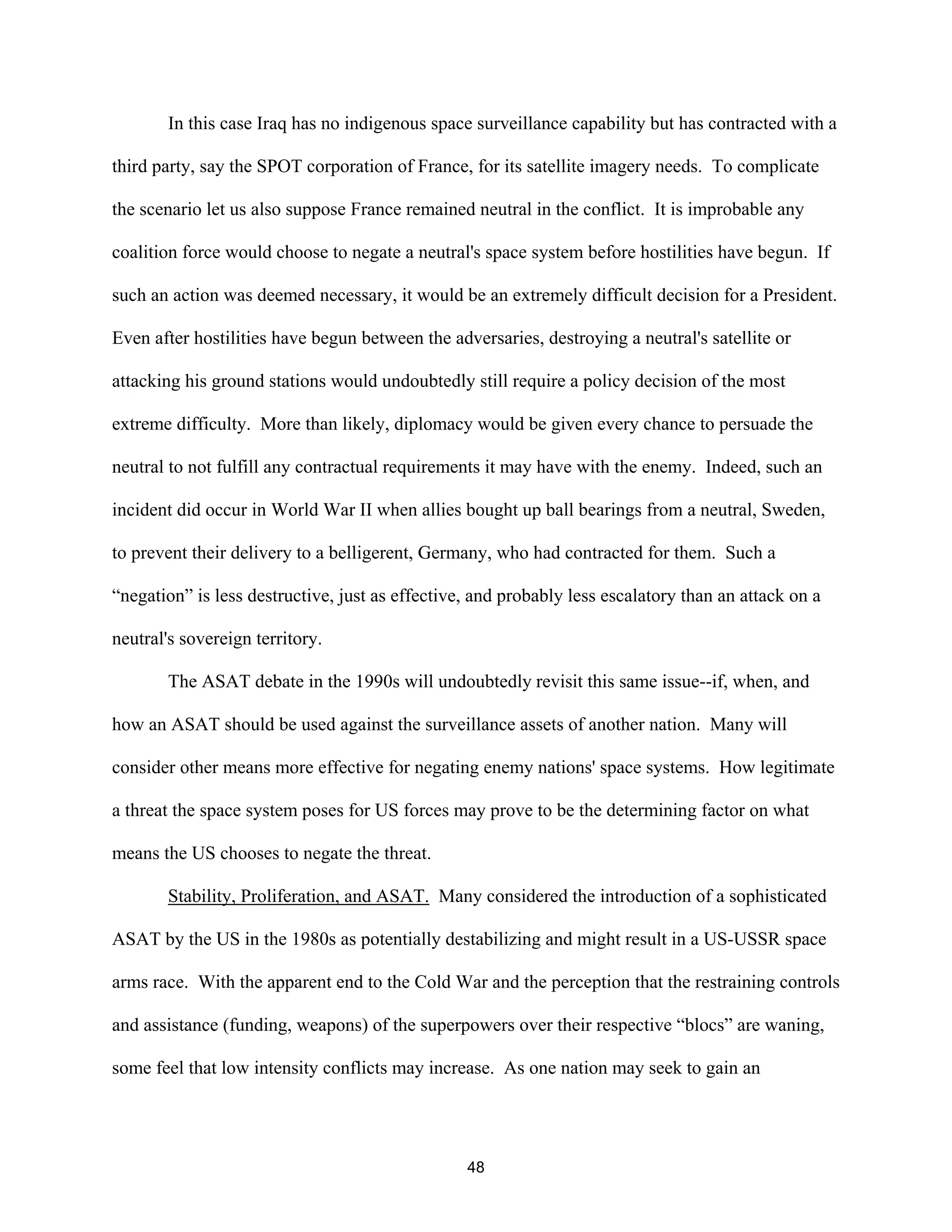
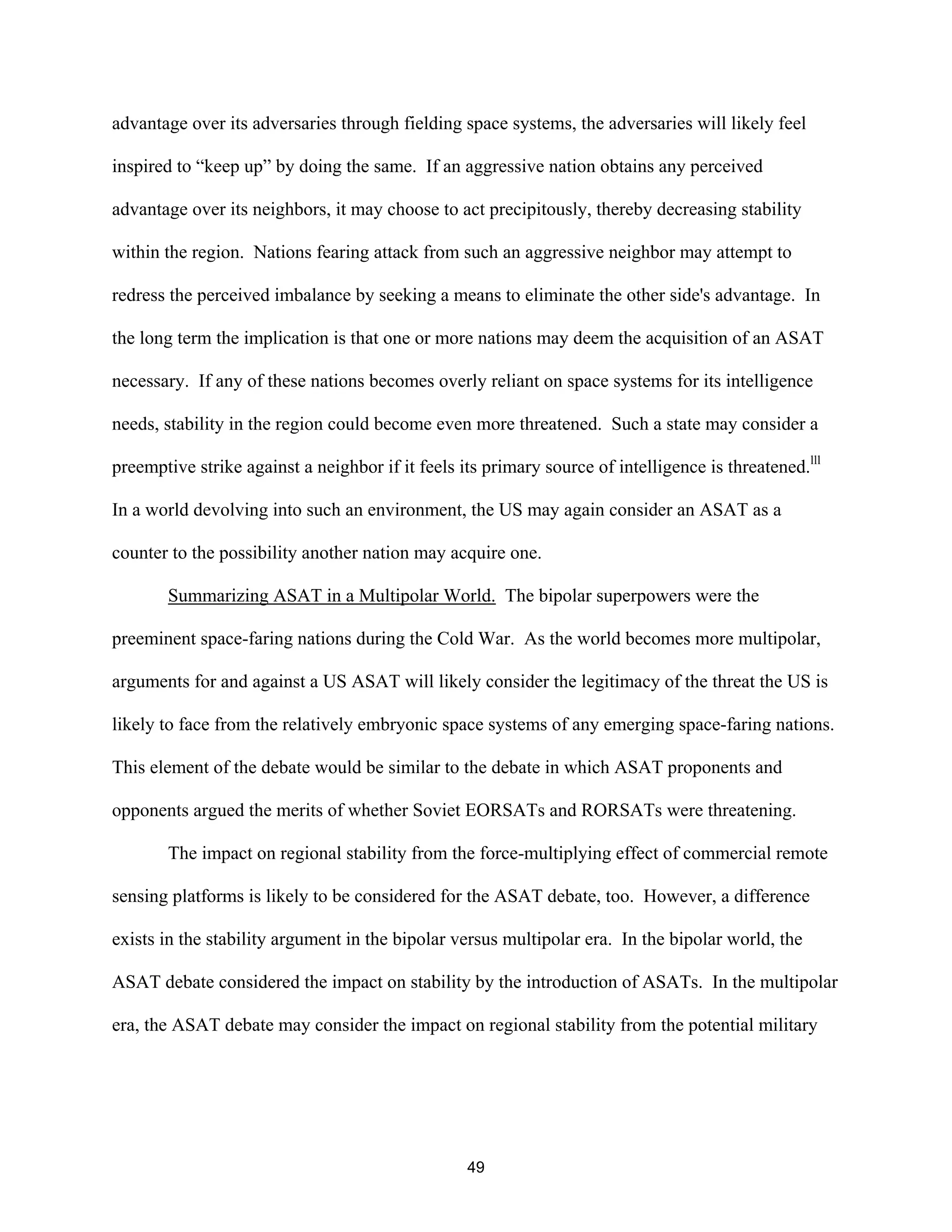
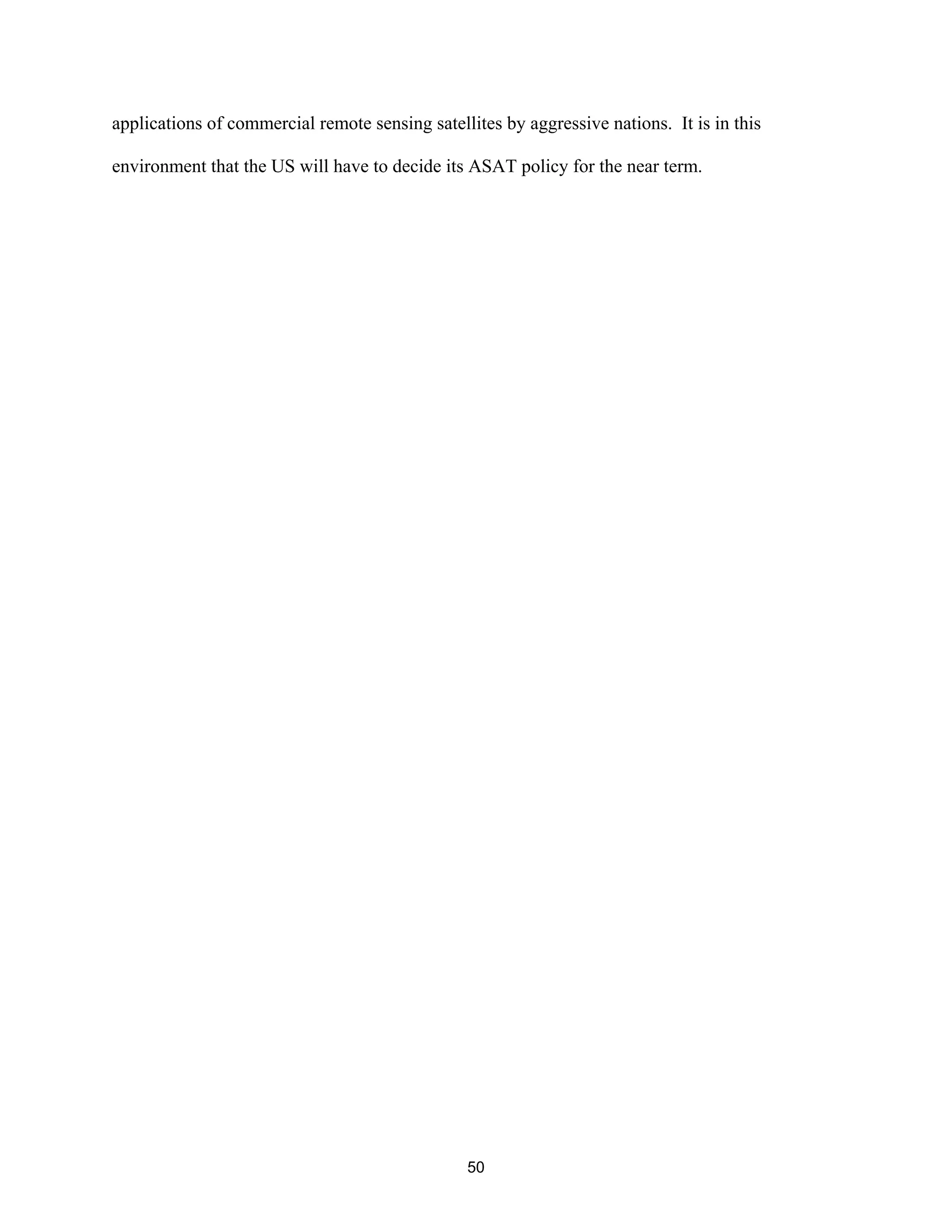
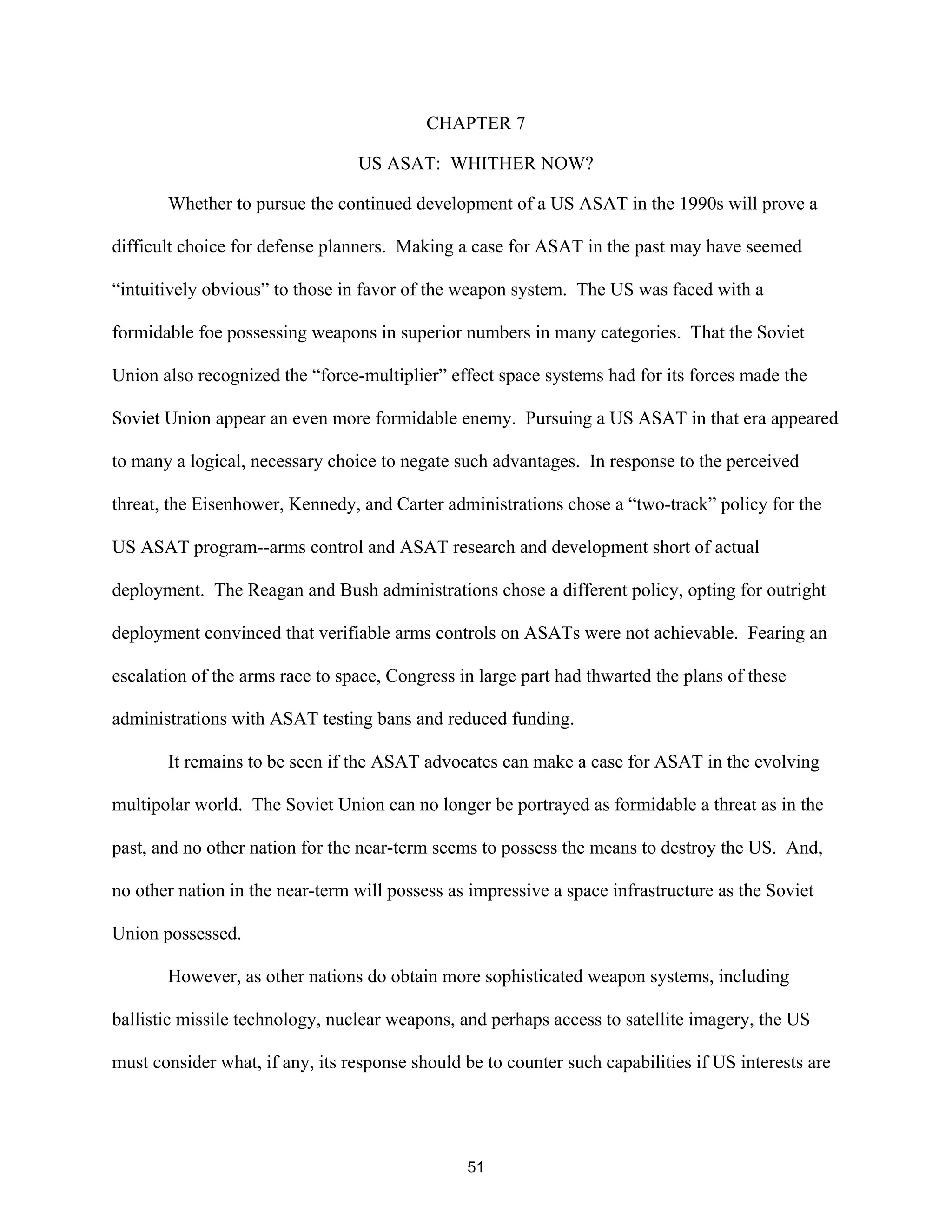
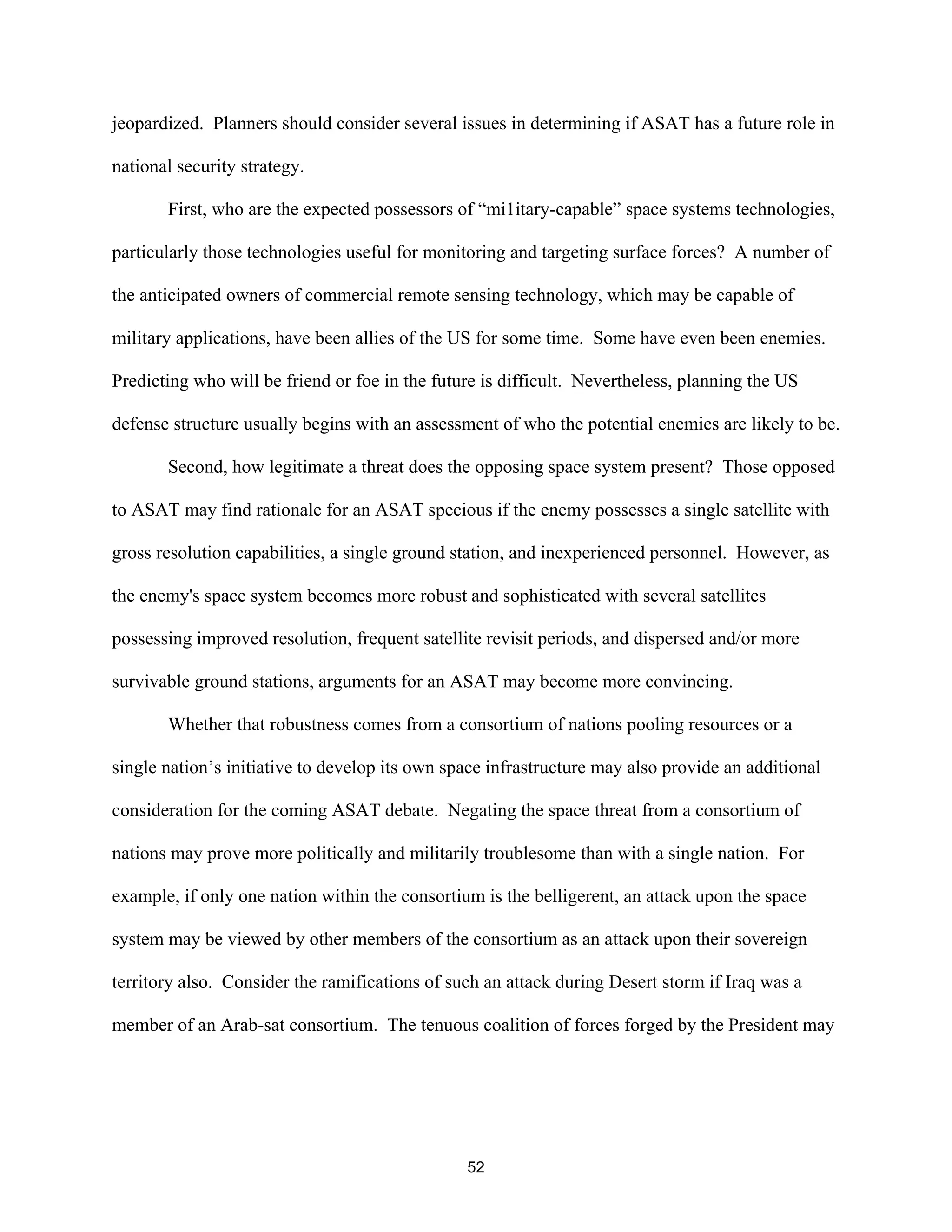
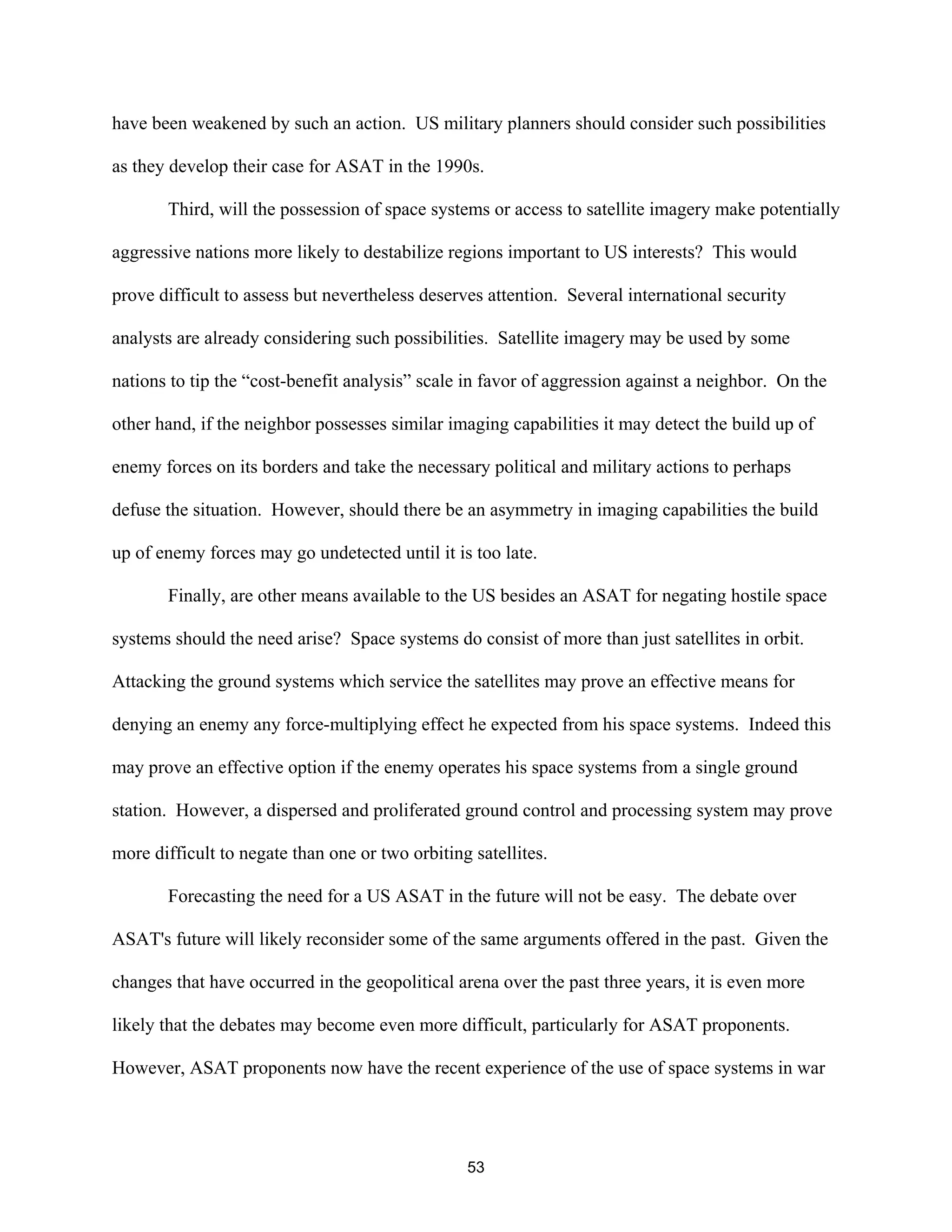
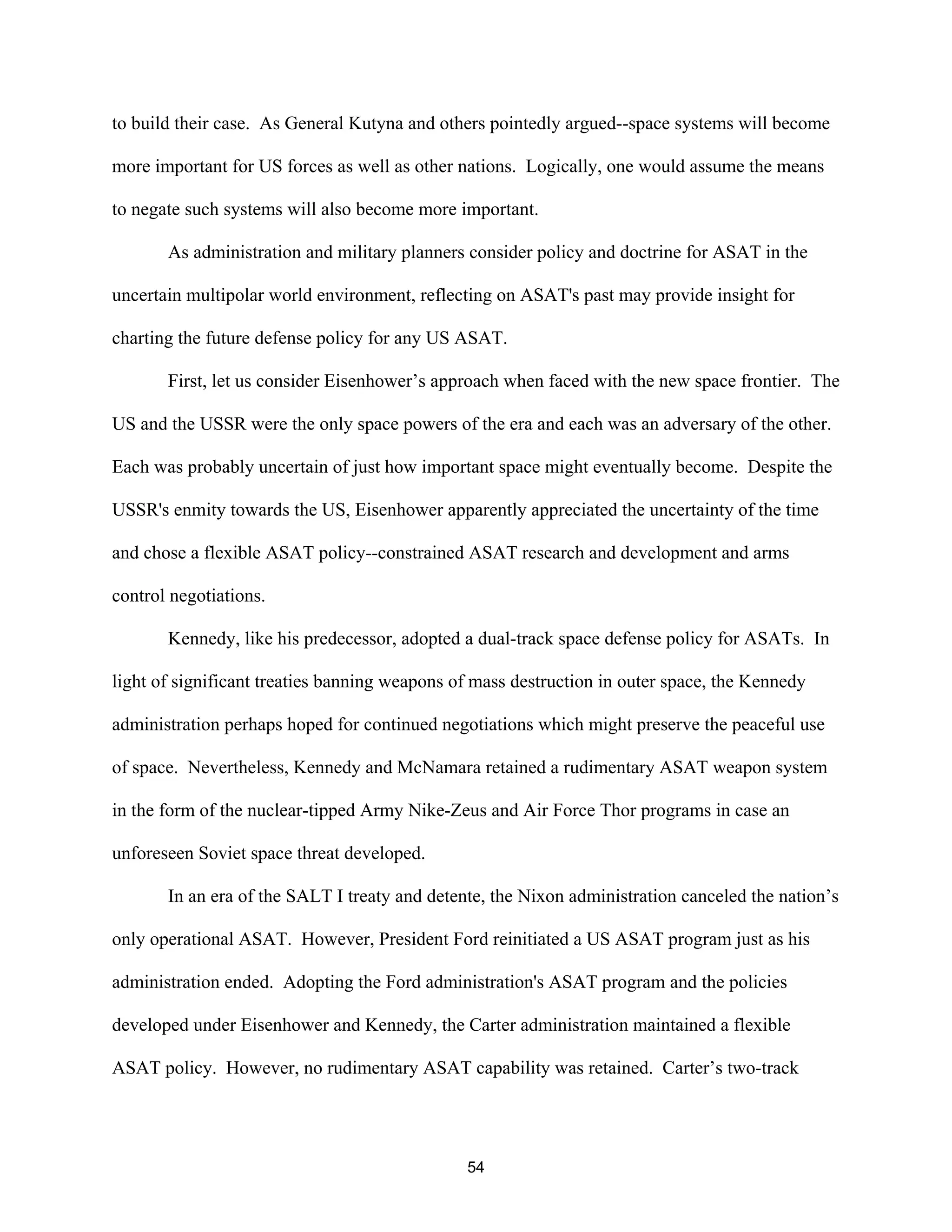

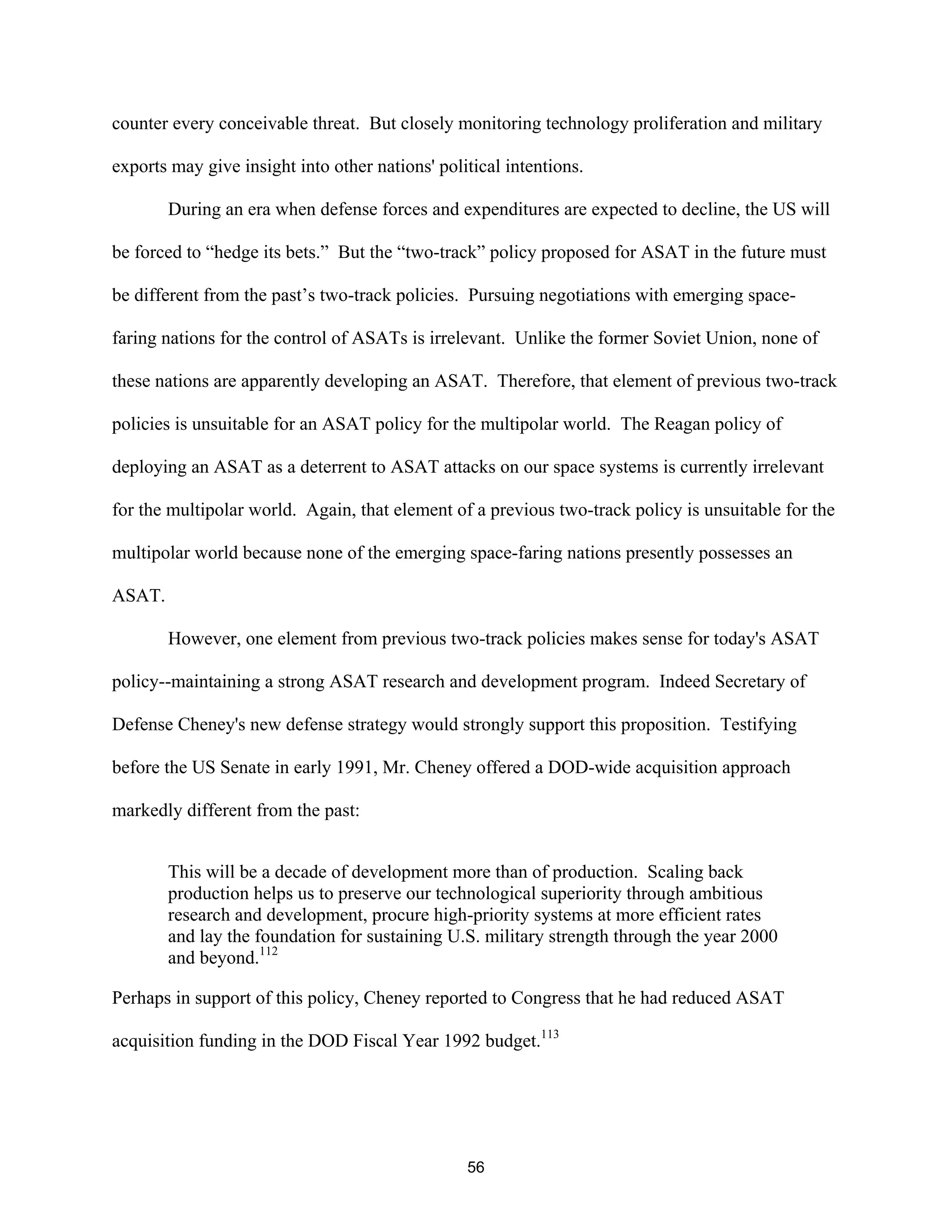
![Collective security should be the other element for the 1990s ASAT two-track policy.
Albeit a broader interpretation of a past two-track policy element--negotiations--collective
security makes sense for the US ASAT policy in the developing multipolar world. In the past
negotiations served to control the feared escalation of the arms race into space, vis-a-vis
antisatellites. In the multipolar world’s future, the US is not as likely to be faced with an ASAT
arms race with another country. Instead, it is the potential force-multiplying effect an enemy
nation may enjoy when it integrates its embryonic, but growing, space systems with its
modernizing forces that worries the US. However, Secretary of Defense Cheney expects
“...collective security [to remain] central to U.S. strategy...” as a means for “...contribut[ing] to a
cooperative world order.”114 As an important facet of collective security, Cheney added, arms
control should be used to reduce military threats and inject predictability and stability into
international relationships.115 Such a policy in this case would pursue negotiations with space-faring
nations to prevent dissemination of valuable space systems data to belligerent nations in
time of crisis or war. Furthermore, this policy would seek to control the spread of sophisticated
space systems technology to aggressive nations who might attempt to develop their own space
systems.
Why should this policy seem acceptable for the US for the present? Considering the
number of nations who currently or are projected to operate commercial remote sensing satellites
and the expected capabilities of those satellites, the US can afford to forego deploying its current
ASAT program--for now. The numbers of those nations are few. And as we have previously
discussed, the remote sensing space systems they possess may not have the adequate
characteristics to present a formidable threat. Should these nations become hostile and show
tendencies for increasing the size and capabilities of their space systems, the US in-turn could
57](https://image.slidesharecdn.com/jlefyjqprmysojsst3xu-signature-da39021f777369fcb57be006ccacd597162829cea87ab234b0450f76e72e8bf3-poli-140825182222-phpapp01/75/A-us-asat-policy-for-a-multipolar-world-64-2048.jpg)
